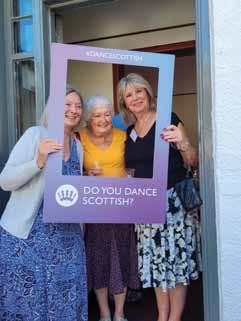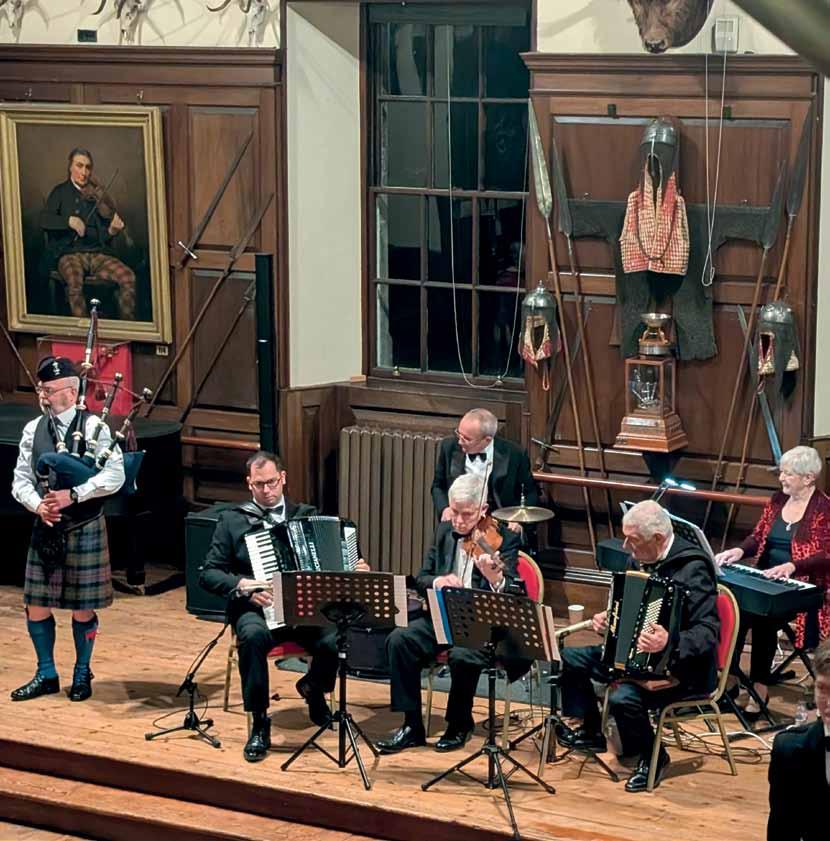























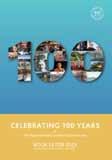


























As part of the Management Board’s ongoing evaluation of the Society’s financial well-being and its commitment to maintaining the value it provides to all members, strategic planning will be undertaken in the coming months, with opportunities for member input. As part of this effort, you will notice a more immediate change in how the print magazine arrives. After researching lower-cost ways of printing and posting the magazine, companies operating as Extraterritorial Offices of Exchange (ETOE) have been identified. These businesses operate in connection with foreign postal operators. ETOEs perform a wide range of postal functions that can vary by country but generally include printing, consolidating, documenting, and transporting outbound international mail. International postage is one of the highest costs associated with the magazine’s production. ETOE companies have legal arrangements with postal services worldwide. This allows them to ship from the UK to all the countries where members reside using local postal rates. Additionally, we are using compostable poly bags to package the issues. Paper envelopes can be recycled, but they are also the most expensive method for shipping magazines.
We are aware that the printed issues are valued by many of you. People often mention the pleasure of seeing the magazine arrive in the post and the enjoyment of sitting with a nice cup of tea and reading, and re-reading, all the articles and looking for friends (or perhaps yourself) in the pictures. Sustaining the high quality of the magazine is essential, and one more subtle change will be the type of paper used. Rather than Gloss paper with its high sheen and shiny surface, we can gain cost savings with Silk paper. This is less reflective than gloss paper, which reduces glare and makes text easier to read while retaining a professional finish. This issue highlights the experiences of dancers, musicians, and teachers who have made significant contributions to Scottish country dancing. The joy and enthusiasm expressed by the Bertani family’s article about their experiences at Summer School is infectious. It also demonstrates the importance of opportunities like the Family Scholarship in fostering and sustaining a love of dancing.
Anne McArthur, from Banffshire, was awarded the British Empire Medal (BEM) by the King in the New Year Honours List in January of this year. The BEM is a special award presented to individuals who have made significant contributions to their local community. While undoubtedly pleased to have been recognised, Anne feels she was simply sharing what she loved with dance students and friends throughout the years. Though one might say she did that with aplomb!
The interview with Chair-elect Sebastian Wanless offers a fascinating glimpse into his distinguished career; his professional experience bodes well as he helps guide the Society into its next century.
We look forward to the publication of Book 54 and the accompanying CD by Neil Galloway’s band. You will enjoy learning more about Neil’s experiences in the article by Jeremy Hill, the new Convenor of Membership Services.
Marjorie McLaughlin, Editor, San Diego, California
Cover: Musicians at the 2025 Winter School Ball in Blair Castle. The musicians are: accordions, Ewan Galloway and Jim Lindsay; fiddler/violin, Ian Robertson; piano, Muriel Johnstone; drummer, Malcolm Ross; piper, Angus Clarke. Photo by Lyndsay Walker.
The next issue of Scottish Country Dancer will be published in October 2025. Please refer to Notes for Contributors on the website. Send materials for inclusion to the editor: mag.editor@rscds.org no later than 31 July 2025. Please send enquiries about advertising to Cécile Hascoët: mag.advertising@rscds.org
Royal Scottish Country Dance Society 12 Coates Crescent, Edinburgh, EH3 7AF Website Telephone Email www.rscds.org 0131 225 3854 info@rscds.org Graphic Designer Its All
10 The Haughs, Cromdale, Grantown on Spey, PH26 3PQ info@itsallgood.org.uk t: 07729 439 514 Printer
Lavenham Press Ltd, Arbons House, 47 Water Street, Lavenham, Suffolk, CO10 9RN


Aberdeen (Scotland) 100 years
Dundee (Scotland) 100 years
Perth & Perthshire (Scotland) 100 years
West Renfrewshire (Scotland) 100 years
London (England) 95 years
Hamilton & Clydesdale (Scotland) 90 years
Manchester (England)
Boston (USA)
90 years
75 years
Cape Town (South Africa) 75 years
Carlisle & Border (England) 75 years
Castle Douglas (Scotland)
Forres (Scotland)
75 years
75 years
Monklands (Scotland) 75 years
Newcastle-upon-Tyne & District (England) 75 years
Sheffield (England)
Bournemouth (England)
San Francisco (USA)
St Catharines (Canada)
Northern Virginia (USA)
San Diego (USA)
Twin Cities (USA)
Washington DC (USA)
York & North Humberside (England)
New Mexico (USA)
Phoenix (USA)
Youth Branch (International)
AuTumN GAThEriNG rEsulTs 2024: Elections:
Management Board:
l Gary Coull is now the Chair.
70 years
60 years
60 years
60 years
50 years
50 years
50 years
50 years
50 years
40 years
40 years
10 years
l Sebastian Wanless joins the Management Board as Chair Elect.
l Christopher Smith and Charly Candia join the Management Board for a three-year term.
Education & Training:
l Graham Donald joins the Education & Training Committee as Convenor Elect.
l Abbie Brown, David Queen, and Fiona Grant were elected for three years each.
l Deirdre MacCuish Bark was elected for two years.
Membership Services:
l Jeremy Hill is now the Membership Services Convenor.
l Susan MacFadyen and Beatrix Wepner were elected for three years each.
l Niall Bootland and Paul McKnight were elected for two years each.
l Katharine Hoskyn and Deborah Crossley were elected for one year each.
Youth Services Committee:
l Linda Williamson is now the Youth Services Convenor.
l Emma Sellke and William Thomson join the committee for a three-year term each (no election required).
The Management Board, Committee and Working Group vacancies due to be filled at the AGM this November 2025 are as follows:
l Management Board: Trustees 2 (for 3 years),
l Membership Services: 2 (for 1 year)
l Education & Training: 2 (for 3 years)
l Youth Services: 2 (for 3 years)
The deadline for committee nominations is Saturday, 13 September 2025.
The deadline for AGM motions from branches: Saturday, 16 August 2025.
Head to your Branch committee for further information, or log in to our Volunteer Page:
We need your skills and talents, wherever you are! https://rscds. org/volunteering
sCroll of hoNour 2024:

Brian Charlton (right),awarded a Scroll for his 37 years of commitment to the RSCDS.
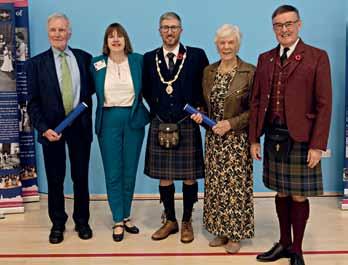
rs CD s s ubs C ri PT io N f EE s for 2025-2026:
Please note that at the recent AGM 2024, the following motion has passed:
“The Management Board proposes that for the year from 1st July 2025, the basic full annual subscription shall be increased to £29 per annum, with other membership subscriptions based pro-rata on this amount”.
Below are the fees. Each Branches will then add their own fees on top of the RSCDS Membership.
“RSCDS Memberships help us to continue our mission to raise the profile of Scottish country dance and music on a global scale. This ensures development of resources, provision of events, and the delivery of educational and teacher training programmes.”
Category
Adult single (25+)
Young adult (18-24) (80% of adult rate) £23.00
Youth (12-17) (50% of adult rate)
£15.00
£22.00
Junior Membership under 12 0.00 0.00
Affiliation fee
Youth Affiliation Fee (where 50% of members are under 25 or in full-time education)
£64.00
£32.00
New Affiliated Group b rings s cottish Dance to m elbourne: s cottish Country Dance victoria. scdvictoria.com/
We are thrilled to announce the addition of a new affiliated group in Australia, expanding our global community.
With a mission to introduce the joy of Scottish Country Dance (SCD) to a broader audience, this group aims to give Melbournians the chance to experience and embrace this vibrant dance style throughout 2025. Get ready to dance, Melbourne!
historic 12 Coates Crescent Welcomes New Tenant to i ts l ower Ground f loor s pace.
The prestigious office at 12 Coates Crescent, traditionally spanning two floors, has undergone a recent change in its occupancy. The ground floor continues to house three offices, a boardroom and a post room, while the basement— used for storing stocks and archives—has now found a new purpose.
Since January 2025, the basement has been leased to Rhona Maclean, founder of Edinburgh Body Tonic and a certified GYROTONIC® instructor. This marks an exciting new chapter for the building, blending its professional heritage with a dynamic wellness space.
“I trained in classical ballet but at the age of 21, I had to stop dancing due to a rare muscle disorder called myasthenia gravis. Dancing had really helped me manage my condition so I kept that range of movement by using Gyrotonic for recovery and long-term well-being.
Gyrotonic was developed from a practice originally called Yoga for Dancers. It improves posture, mobility, and joint lubrication, leaving clients feeling taller, lighter, and more fluid in movement. It feels like a combination of massage and exercise! The machines are designed to assist movement, mimicking the sensation of water while strengthening and stretching the body.
I opened my Edinburgh studio in 2011 after my teacher moved away. It took time to grow, but now I have a busy studio with clients from as far as Perthshire, ranging in age from 9 to 84. I knew that I wanted to have a slightly bigger space and to run therapies that complement Gyrotonic and 12 Coates Crescent was an ideal location and had the extra room that I was hoping for. It was even more perfect that it was the Royal Scottish Country Dancing Society and that I’d be renting from a dance related organisation.”

Gyrotonic.
Archive News:
We welcome Kay Munn and Alena Shmakova, new archive assistants who will assist Alan Macpherson with cataloguing, scanning and photography.
Kay Munn grew up in Glasgow, Scotland, where she was introduced to Scottish country dancing in school. She emigrated to Canada in 1986, and has lived in the Toronto area, South Carolina, and upstate New York. She is well-known for the strathspey, The Flower ofGlasgow,“which was written for Kay Munn of Kingston, Ontario, Canada.” She is now back in Scotland and looks forward to starting on the RSCDS Archive along with Alan Macpherson.
Alena has extensively researched the Scottish dance scene, collecting dance and dance music sources printed or written in Scotland and straining through diaries, memoirs and private letters from the eighteenth and nineteenth centuries. She studies history at the University of the Highlands and Islands (MLitt in History (part-time)). Alena presented her research at international conferences and as public talks.
(https://www.danseantique.com/about-us/)
Have your say! Have a question or comment? – please contact us!
Gary Coull, Chair chair@rscds.org
Sebastian Wanless, Chair-Elect ChairElect@rscds.org
Lizzy Conder, Treasurer treasurer@rscds.org
Convenor of Membership Services msc@rscds.org
Convenor of Education and Training eandt@rscds.org
Convenor of Youth Services ysc@rscds.org
Board Trustees and Staff in Coates Crescent: info@rscds.org
By post: 12 Coates Crescent, Edinburgh, EH3 7AF. All correspondence will be forwarded to the appropriate person.
Want to receive the scottish Country Dancer in an interactive digital magazine? Go to your Edit my profile and update your preferences.
Alternatively, contact your branch membership secretary.

Gary Coull
It is an absolute honour to take on the role of Chair of the RSCDS, and I’m excited for the journey ahead. Scottish country dancing has been a huge part of my life, and I feel privileged to work alongside so many dedicated dancers, teachers, musicians, volunteers, and staff who make our Society what it is.
First, I want to say a huge thank you to William Williamson, who was exactly the right person to be Chair during our Centenary year. His leadership, enthusiasm, and dedication were invaluable, and I know we all appreciate the hard work he put in during such a momentous time. I’d also like to take this opportunity to thank his wife, Linda, for her support during that period. I’m also delighted that Sebastian Wanless is now in place as ChairElect, and I look forward to working with him over the next couple of years.
Since becoming Chair, I’ve been fortunate to meet many of you at events, branch visits, and online. It’s always inspiring to see the passion and commitment that exists throughout the RSCDS. The sense of community within the RSCDS family is truly remarkable. I am continually reminded of the immense joy that Scottish country dancing brings to people of all ages and backgrounds.
Our Management Board has also been working hard on your behalf, particularly with the production of our new five-year strategic plan, ensuring we have a clear direction for the future. Financial stability is another key focus, and we are taking steps to ensure the Society remains strong for years to come. Our committees are also working hard to bring forward new initiatives. I’m constantly amazed by the fantastic work happening in our branches. I encourage you all to think outside the box and try new things. Use fresh approaches to engage your communities and to grow the number of dancers. And remember, don’t just try it once! If something doesn’t work the first time, tweak it and try again. Innovation and creativity are key to keeping our dancing fresh and appealing to new generations.
Increasing our membership is one of the biggest challenges we face as a society. We all love Scottish country dancing, and we know the benefits it brings—not just in terms of fitness, coordination, and musicality but also in building friendships and creating a true sense of belonging. The more people we can bring into our RSCDS family, the stronger our Society will be, which in turn will support the promotion and preservation of this wonderful pastime.
So, I am setting a challenge for us all – to bring in just one new member. Imagine the impact we could have if each of us encouraged just one friend, family member, or colleague to join the RSCDS! Whether they are new to dancing or returning after a break, let’s welcome them with open arms and show them the joy of what we do.
I’m optimistic that together, we can ensure that Scottish country dancing continues to thrive for generations to come.

It’s a great pleasure to have taken up the role of Convenor of MS in November, and to join the Board. Although I’ve been involved over the years at a branch level, it’s only recently that I’ve felt able to get more involved in the global organisation. I’ve spent my professional career working with and in multinational companies, and balancing ‘local’ with ‘global’ has been a key part of that activity. I’m looking forward to seeing how I can apply some of that for the benefit of the RSCDS.
I’ve an eager but almost entirely new Committee to work with: Paul McKnight, Deborah Crossley and Bexi Wepner were all seconded last year, but have now taken up full positions, joined by Susan McFadyen, Kathyrn Hoskin and Niall Bootland.
As Music Director, Luke Brady remains a key player, and I’m delighted to have Ian Muir taking up his role as Music Directorelect. Luke and Ian have embarked on an important review of how best to support the many musical activities of the Society.
It’s great to have wide representation on the Committee, including geographically from New Zealand and Austria, as I want to ensure that we are representing views from right across our global community. That community was reflected in the very successful Dance around the World event held in November, with more than 40 groups signing up to participate – see https:// www.youtube.com/watch?v=DSEzlo7eI-k for a round the world 360 degree compilation of The Laird of Milton’s Daughter.
Publications and related activities remain at the centre of what we are doing, and I’m very excited that we will be publishing Book 54 this summer, with an accompanying recording from Neil Galloway and his band – see the interview elsewhere in the magazine. We are working on delivering digital versions to these publications (book and recording) at the same time – watch out for further details in the coming months.
We are also looking at a longer-term plan for publications, to ensure that we continue to provide materials of value to members, in support of the Society’s objectives, within the appropriate price.
At the same time, we need to broaden our thinking to consider the overall member proposition, which I consider a necessity if we are to increase our membership. We need to address the fundamental question of why people join: is it to support our objectives and activities? To get discounts for events or purchases? To access materials available only to members? To participate in local branch activities?
This is where it’s so important that we are joined up across the Society. To that end, I’m excited to be working with the staff at 12 Coates Crescent, my fellow Convenors, Deb and Linda, the Executive Team, the rest of the Board, and ultimately our members and supporters around the world. I’m keen to draw in opinions and suggestions that you may have, so please do get in touch.
msc@rscds.org
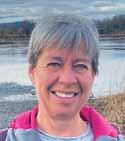
Deb lees
As we start the new year, I am very excited to welcome five new, enthusiastic committee members to help move our plans and projects forward over the next few years. The main focus continues to be on developing teachers and instructors to lead classes of all types and levels, giving them the training and resources they need to teach classes and groups already in existence and start new ones.
We know that people come to Scottish country dancing for many different reasons, and we need our teachers to make their class an experience that dancers want to come back to the following week and bring their friends too. Those already dancing know what a fantastic hobby it is, but we need more people to join in to continue to thrive in the future. So, in the coming year, one of our projects is to look at resources and strategies for teaching newer dancers and giving them the confidence to attend social dances and events, such as the dance grading system that has been introduced at the RSCDS Summer and Winter Schools. Enabling access to video resources to support teaching will be part of this project, both signposting to existing material and creating new resources. The quarterly Teachers’ Newsletter will continue to be sent out to anyone interested in information and articles related to teaching; you don’t need to be a qualified teacher to receive it. The Virtual Teachers Conference takes place at the end of February again, and it has a range of topics that we hope will stimulate learning and discussion across our worldwide organisation, as it has in past years.
Training of new teachers is always high on the agenda, and we have begun a review of our current training programmes to ensure that what we offer best meets the needs of the aspiring teachers and the dancers they will be teaching. A new Tutor Training Course has been developed with three courses held around the world last year and the newly trained tutors will shadow or be mentored by experienced tutors as they develop their skills. We have also appointed five new examiners who will begin their probationary period over the coming year. Numbers for the Unit 1 exam have been very good for recent exams in October and March, and there have been a number of applications to run Unit 2, 3 and 5 courses at a local level. We have also run three more CTI Trainer courses, with several of those Trainers already supporting new CTI trainees. It feels like there is a real demand again for teacher training, and we will definitely need all those new teachers to bring Scottish country dancing to new audiences.
As always, my thanks to all of you who do so much to ensure people can learn and enjoy SCD, whether that be teaching, training teachers, being involved in a Teachers’ Association or a committee, or simply coming to a class or dance, welcoming and supporting others to take part. Every role is important!

linda Williamson
First, I would like to say a special thank you to Philippa McKee for her invaluable support over the last three years. Thanks also to Elisabeth Witter for her contribution to the committee’s work and to Zoe Hill for her ongoing work updating the website’s Young Dancer pages.
All committee positions have been filled for the first time in several years, and I am delighted, along with Beth, Lucy, Shona, Sarah, and Lyndsay, to welcome Emma Sellke and William Thomson to the YSC. Outlined below are just some of the projects that have already taken place and others that are ongoing.
The YSC had the opportunity to meet with Lorna Valentine, Chair of the Scottish Schools Working Group [SSWG], at the end of last year and looks forward to engaging with Lorna again.
In February, the YSC members were grateful for the opportunity to attend the Newcastle Festival, share information on the committee’s work, and seek ideas on future events, such as themes for the Virtual Festival.
Scholarship panels continue to meet, with three full and one-half scholarships being awarded for the Melbourne Southern Fling weekend in November 2024. By the start of February 2025, over 80 young people had applied for the Spring Fling Brighton event [must have been the Brighton rock!] and seven young people were awarded full scholarships.
A Southern Spring Fling is being considered for February 2026 in the Canberra Capital Region and Spring Fling 2026 will be held in Lyon from 10th - 12th April. If anyone is interested in hosting a future Southern /Spring Fling, please e-mail ysc@rscds.org Should you need further information, a guidance document, jointly produced by the YSC and previous Spring Fling Committee organisers, is available.
Since the free RSCDS Junior Membership launch, membership numbers have increased from 57 in 2024 to 115 at the start of 2025. To register a child for Junior Membership, please contact your local RSCDS Branch and complete a Junior Membership application form. Each junior member will receive an RSCDS Junior Activity Book after completing the application form. If you do not have a local RSCDS Branch, you can still register by contacting 12 Coates Crescent via info@rscds.org
Plans for Junior Summer Camp [JSC] and Young Dancer Week 2025 [20th - 27th July] are well underway, and we very much look forward to welcoming new and returning young dancers.
There will be the opportunity to participate in a brand-new RSCDS event ‘Families and Friends Weekend’ designed for people aged 35 or under and their parents or legal guardians along with dancers of 40 and under. The event is being held in Moffat, Dumfriesshire, from 19th - 21st September 2025. We were delighted to be able to offer the new Hill Family Scholarships, this weekend and would like to say a huge thank you to the Hill family for this kind gesture. For further event information, please get in touch with ysc@rscds.org
Finally, a plea to all dancers and musicians: Let’s make the 2025 Virtual Festival the best ever. It would be great to see even more entries from across the world!
last November, sebastian Wanless, ex-chairman of the Glasgow branch, became the society’s ChairElect. sebastian has had a very distinguished medical career in clinical research. in addition to being Chair-Elect, he is Chair of the rsCDs health strategy Working Group. in this interview with Jimmie hill, sebastian introduces himself to members and outlines his vision for the rsCDs and what he believes he can bring to the role of Chair.

first things first, tell us where you are from. I was born and raised in Edinburgh. I attended the Royal High School, studied medicine at Edinburgh University’s world-famous Medical Faculty, and obtained a PhD at London University.
reading your biography, you appear to be scotland’s renaissance man – embracing the worlds of science, literature, and languages.
That may be a slight exaggeration, but I speak Russian, French, Japanese and a bit of Italian. My Italian is not as good as the other languages. I learned it by ear from a Sicilian speaker. I also speak reasonable Finnish! I tried to learn Romanian when I lived there, but I was a bit older, and the younger you learn a language, the better.
our Japanese members will be interested in knowing why you speak Japanese.
It was when I was working in the US in clinical research for a multinational pharmaceutical company. I was asked to go to Japan to be in charge of clinical research for the company. Before I went, I knew I would work almost exclusively with Japanese speakers with little English. So, I spent six months learning Japanese using the Berlitz method. My teacher was a woman, so I basically copied her. Japanese men and women don’t speak the same way, so when I arrived in Tokyo, my colleagues found my Japanese very amusing as I had learned it from a woman! I then had to learn how to speak like a man. It was essential for my work, and I still have many good Japanese friends. In Tokyo, we lived in the Shibuya area, not the ex-pat area, so I met lots of local Japanese people. We love Japan, and if we weren’t living in Scotland, Japan would be our next choice.
but you have lived in many other countries too.
Yes, I started in Belgium, then took up a post in the US. Japan came after that, then back to Western Europe to be in charge of cardiovascular research. I was moved to Eastern Europe, then back to the US where I was Vice President of inter-continental research. After that, I moved into the company’s charitable Foundation and to Johannesburg to head up their HIV programmes for treatment and community support. That was a big change in my career. I was there for five years. I then retired but was persuaded out of retirement to work for Baylor College of Medicine’s Paediatric AIDS Initiative, based in Romania. I travelled widely through southern, west and east Africa. We had a clinic in Romania and then built seven clinics for children with HIV in Africa. My wife and I then moved back to the UK, to Glasgow. So that is 31 years of living all around the world.
so, you came back and started scottish country dancing.
Until then, my wife and I had done ballroom dancing in the US and South Africa, but she had always admired Scottish country dancing and wanted to try it. We went to a beginners’ class in Westerton, in the Bearsden area of Glasgow. We progressed, and somehow or other, I soon found myself on the Glasgow Branch committee, then became Branch Chairman—and now Chair-Elect of the RSCDS.
When you chaired the Glasgow branch, what challenges did you face?
It was 2021, so nobody had been dancing for virtually two years. All the classes had to be restarted, along with the programme of dances and all our outreach activities. It was clear we would have a problem with reduced numbers after COVID. I persuaded
the committee to do two things. Firstly, we engaged a social marketing company that designed a survey for social media to find out the general public’s view of Scottish country dancing. Then, we used the results to design a marketing campaign that was launched in August 2021 in time for the start of classes. Fifty-two new people turned up, and out of those, 33 became members or regular dancers, and those new people replaced the ones we had lost over the pandemic.
Of course, another major challenge was implementing all the health and safety precautions. Sir Harry Burns, who had been the Chief Medical Officer for Scotland, helped us with the public health aspects of the situation.
Why do you think Glasgow is a successful branch?
At a certain point in the not-too-distant past, we had got away from this rather formal, traditional approach to country dancing. We have been very attentive to creating an informal and positive ambience, particularly at dances. We had very successful ‘Nice and Easy’ dances to encourage our new people; we started free taster classes; we had preparatory classes before dances and balls so that all our dances became inclusive and welcoming events. We were prepared to try new things, rather than just repeat what the Branch had always done.
I should add that after COVID, Branch membership remained the same, but attendance at classes had dropped. Straight after COVID, classes made a loss. The next year, the Branch broke even as a result of changes to class format and re-energised, well-attended dances; then, in the next year, the Branch was back in profit.
In the Branch, we have an Outreach Convenor. I don’t know how common that is among branches. It is so easy to be REactive rather than PRO-active in terms of outreach. One of our recent outreach initiatives is a class in the east end of Glasgow in Barlanark, an area of housing schemes. The class is a collaboration between the branch, the local Barlanark community, and Glasgow Life. Glasgow Life is a community charity which works city-wide. It has four remits: to advance culture and sport; to improve the mental and physical wellbeing of local communities; to support the vibrant city

Sebastian and his wifeTamara.
economy; and to re-invest income to achieve their vision. The Barlanark class is for beginners, and I am delighted to say it is thriving. It shows that country dancing is for everyone. If there is a lesson we can share with other branches, it is that to start a new class somewhere, you must work with the local community and social agencies. You can’t just advertise a class and hope it works.
Glasgow is well known for encouraging young teachers to qualify.
Previous Chairs Fiona McDonald, Muriel Bone and Margaret Sanders were instrumental in that. We have roughly ten young teachers now. They trained here in Glasgow rather than going to Summer School.
Why did you decide to stand as rsCDs Chair Elect?
It was never my aim when my wife and I went along to that beginners’ class in Westerton! It goes back to my time as Branch Chairman. The first year was getting over COVID; the second year was the social marketing campaign and outreach; and the third was the Society and Branch Centenary Year. I was involved with the Centenary celebrations in Glasgow, so I suppose I became known as someone who could organise things! In my working life, I was part of a very large organisation with hundreds of people reporting to me, so I can bring that experience to the RSCDS. I am not a teacher, and not all past Chairs have been teachers, but I think I am pretty good at organising things. For example, the blue plaque marking the founding of the Society in 1923 at the Athenaeum resulted from my submitting a complicated planning submission to the Glasgow City Council.
have there been any highlights of your time country dancing?
It must be the Branch Centenary Ball in Glasgow City Chambers. The venue is spectacular. It was a cracking good dance and a brilliant event.
in the past there was no defined role for the Chair Elect. it depended very much on how the Chair of the time involved them.
Well, I can assure you I am very busy. William involved Gary very much, and Gary is involving me. I am very involved in the new Strategic Plan. My experiences in Japan and South Africa were very formative. In Japan, all decision-making is consensual, and that is a very useful approach when running a committee or board. In Africa, my work was very practical, on the ground, working with communities and very vulnerable people. That had a big impact on me.
Where do you think the rsCDs is going?
We are now in our second century. I think there is a recognition that we have to change. The world has moved on, and to a certain extent, the society hasn’t. Perhaps we have been a bit inward-looking. You could say we have become a bit remote from the general public. That is what our social marketing campaign taught us in Glasgow, and that sparked change in the branch. William changed attitudes and that is continuing with Gary. We are going to continue to reach out to agencies outside the Society: local community organisations, other dance societies, and other charities. Our new strategic plan includes these things and aims to provide more value to our members. Outreach is the future.
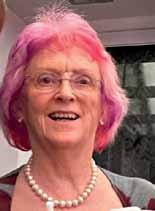
Anne McArthur is a well-known teacher from the Banffshire Branch. She has lived most of her life in the small town of Portsoy, now famous for its annual traditional boat festival. Anne was Convenor of Youth Services and responsible for several innovative projects. She was awarded the British Empire Medal (BEM) by the King in the New Year Honours List in January of this year. The BEM is a special award for people who have contributed greatly to their local community. She was interviewed by her fellow Branch member and RSCDS Chair, Gary Coull.
Where were you when you heard about your bEm?
I was sitting in a hotel in Montevideo, Uruguay. We had been travelling all day from Buenos Aires. I thought I would do my emails and I said to my travelling companion Jim (Stott), ‘This is a queer email’, “We have been trying to make contact with you.”’ I realised it was some kind of award, and the email asked if I wanted to accept it. I replied that I would be happy to receive it, but I was a bit bewildered by it all. The Palace had obviously written to me at home, but I was away, so I hadn’t responded. It was for my community work in Portsoy, where I live, and my work in the Banffshire Branch. It hasn’t really sunk in yet. I was just doing what I like doing. I like my country dancing and doing things in the town that need doing.
how do you feel about it now?
Well, it means I have to keep going! When I got my Branch Award many years ago, I wondered whether it was time to give up, but I kept going.
When do you get the medal?
I have no idea. The BEM is presented locally – usually by the Lord Lieutenant of the County. My dancers have decided that we will have a fundraiser in aid of the new roof for the dancing hall. They want a garden party in the afternoon so that they can dress up and at night they want a ceilidh in the Church Centre for a bit of a knees-up.
When did you start scottish country dancing?
I went to dancing at the age of three. Christine Donald was the dancing teacher in Portsoy. She did a mixture of dancing,

a bit of ballet, a bit of country and a bit of Highland. When I was at teacher training college, I wanted to do my Preliminary Certificate, but there weren’t enough people for a class. When I started teaching at school, I attended an evening dance class. The teacher suggested that I go to St Andrews in the summer to do my Prelim. I could dance, but I really didn’t know all the formations. I was a schoolteacher; I could teach, and I could dance, so I passed. That was 1971. Malcolm and Helen Brown and Fiona Turnbull were in the same class. I taught a class that winter, then went back the following summer and did my Full Certificate. I have been teaching ever since. When I was studying in Aberdeen, I taught the Tuesday class, a children’s class and attended Lena Barclay’s advanced class. When I came back to Portsoy, I set up my own class. I ran a certificate class for teachers in the early 80s, and these teachers went on to teach in the Branch for the next 40 years.
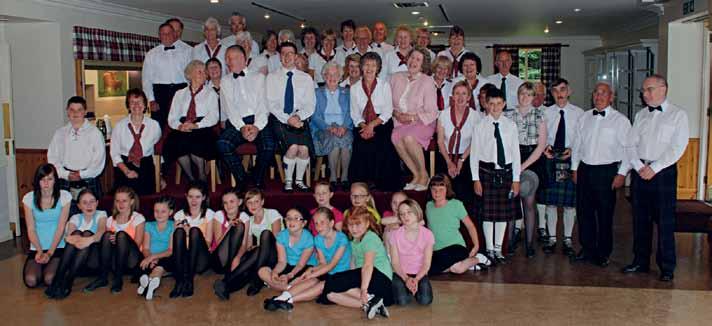

What attracted you to country dancing?
It was my social life where I could have fun, be fit and meet people. We went all around the area: Huntly, Keith, Banff, Dufftown, Forres and Aberdeen. Fifty miles was nothing to travel on a Friday night to a dance. Up here we call them rallies.
What was your career?
I had always wanted to be a primary school teacher. Eventually, I became the Assistant Head at Portsoy School and then the Head Teacher at Portessie. After that, I moved into the Council as an Education Officer until I decided to do my PhD at the Open University. Every night, I taught dancing, either Highland or Scottish country. Friday was rally night.
so, teaching children was obviously important to you. When did you start up your own dance school? It was when I was at university. I didn’t have any income, so I told my Mum that I was going to start my own dancing school. That was 1976. I had 11 children. It’s still going, and I don’t intend to retire until I am no longer fit. I teach Monday, Wednesday, Thursday and Friday. It’s mostly Highland dancing, but I teach country dancing in Fraserburgh on a Friday afternoon. I never had to advertise the dance school. People just appeared. I remember asking some of the dancers who travel to the class why they come, and the answer was, “Well, we live in the country, and there’s nothing else to do.” It’s much more than just dancing. The dancers are my family. The dancers tell me what’s going on at school and discuss their career options. Later, they come to me for a reference when they need one for college or a job. And nowadays, a Highland teaching qualification will count towards university entrance.
One of the things I did when I was on the Youth Services Committee, along with Jim Stott, was create the Accreditation Scheme for Scottish schools. We set three levels and set up a system of awards. I would encourage any school to consider doing it.
What would be your top tips for teaching children?
When I retired, I knew every head teacher in the area, so I was able to go into school and teach country dancing all over the
county. My idea was to get everybody on the floor. I never worried about boys dancing with boys or girls dancing with girls. I was happy as long as they were all dancing and could do 6 or 8 dances by the time I finished. I would rather have every child dancing than have one team of excellent dancers. My aim was to get them enthusiastic and have fun. Other teachers might want to teach a small number of really good dancers to a high standard, but my approach was to get mass dancing and everyone enjoying it. When I became a Convenor of the Moray Music Festival, I knew the only way I could get more schools entering the dance section was to go into schools myself. Sometimes, we had over 200 children taking part. If children have a positive experience of country dancing at school, they might take it up later in life.
And is it more difficult to get into schools postCoviD?
Yes, for me it is. I no longer have the contacts. The head teachers have all moved on. Personal contacts are essential.
A lot of places seem to be starting afternoon classes nowadays.
Yes, my Fraserburgh class is in the afternoon as I was not willing to travel a long distance on a winter’s night. Because it is an afternoon the dancers are 60+, but a class with a couple of sets is positive. In our Branch, we have nine evening classes and two afternoon classes.
is your experience abroad?
My initial experience abroad was when I was Convenor of Youth Services. I oversaw the development of Spring Fling. When I was first involved, we had about 40 people attend, but some of the younger teachers got more involved. Spring Fringe started, and Spring Fling grew. The ones in Lyon, London and Edinburgh were very good. The ones in Bonn, Glasgow, and Paris were very well attended. I felt that during my time as Convenor, Spring Fling bedded down and became sustainable.
Meeting, dancing, and teaching with the BASC dancers in Argentina has been exciting as most of my country dance work has been here in the North East of Scotland.
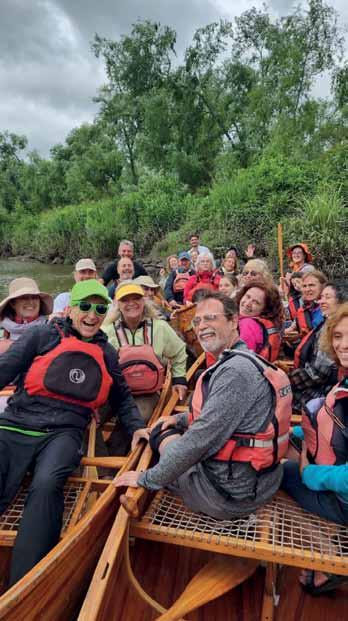
On the waterway atTigre.
I think one of the things I am proudest of was setting up Junior Summer School with Marilyn Watson when Jim Stott was the Summer School Director. Now, it is an established part of Summer School. I was also Convenor when we set up the first Virtual Festival.
What message would you give to branches thinking of starting something new?
It’s always good to think out of the envelope. Up here, we have had children’s rallies, days of dance, day schools and very successful dances. There were some years when numbers were down, but you keep going, keep broadcasting what you are doing, and things pick up. We had a lot of children, then along came COVID. You always try out new ideas.
What are some of your best memories of dancing?
The most obvious was when the Branch was invited to dance for the late Queen at Balmoral Castle in 2009 to celebrate our 80th Anniversary. The Branch was totally astounded the night we told them. You [Gary Coull] and I had to go over to Balmoral in advance and see the ballroom, meet the Lord Lieutenant, and hear what they were expecting of us. We took a bus with 57 dancers over to Balmoral. Dancing to Jack Delaney and Colin Dewar’s band was pretty amazing and something we will never
forget. Meeting the Queen and hearing her comments on the dancing was really special. After we had danced, she spent 20 minutes chatting with the dancers. She was so relaxed with our folk. I don’t think anything could surpass that.
Another more recent memory was in Argentina last November. It was the end of the dance season, and the BASC dancers had a day out. We drove to Tigre, just north of Buenos Aires, and we all went in canoes along the waterways. We came to this building, which looked like a gigantic shed where we had a workshop. The atmosphere was so happy and optimistic; it was one of the happiest days of my life. It’s all thanks to the RSCDS that so many people can come together from anywhere in the world, dance together and become friends.
Why is the rsCDs important?
I’ve been a member since 1971, which is 54 years. It’s my lifeblood. It’s where I learned all my technique and all my teaching. The RSCDS has brought all the dances, the dance technique, and the formations together and made them available worldwide. It means I have been able to go to a Spring Fling in Canada, a dance weekend in Japan, and classes in Argentina, and we all danced in a similar way.
What does the future hold for the rsCDs?
Here in Banffshire, we, the young teachers of the 1970s and 1980s, are now 70+. Most of our dancers are of a similar age. We welcome their continued support but recruiting younger people is a dilemma for our Branch and the RSCDS as a whole.
What is your favourite tempo?
Definitely, Strathspey.
And what about favourite dances?
The Duchess Tree, Miss Gibson’s Strathspey,Autumn in Appin. These are the ones I always ask a man to dance with me. These, for me, sum up what Miss Milligan meant by ‘dance with your soul.’
Your bEm was awarded both for your work in country dancing, but also for your community work in Portsoy.
Yes, I am very involved locally. Some of what I do is linked to the dancing. I put on demonstrations at community events. I’m involved with the Scottish Traditional Boat Festival every June/ July. I’m a Director of Portsoy Community Enterprise, which runs a small cultural museum, a boat shed where we build traditional boats, and a community space. We also run the caravan site and a 4-star hostel. I also manage two halls in Portsoy and am involved in the life of the church.
Who inspired you?
Pat Lemmon. She is now in her late 80s. She went to St Andrews for two weeks every year. Her technique was exceptional. Her love of Scottish country dancing transferred to me. She came to my Banff class until COVID, and she still had the same expectations of herself and of me.
What does scottish country dancing mean to you?
It’s my whole life. I’ve been dancing for 72 years now. When I was busy at work, I did less dancing then, when work was quiet, I did more dancing. Dancing has always run parallel with the rest of my life. And I just hope I can dance far into the future.
Dawn bertani, los Angeles branch

Iam writing this article from a place of overwhelming gratitude to all parts of the RSCDS community: to those we met at St Andrews this year; to the RSCDS directly; and to our Southern California SCD friends who initially inspired and supported us in this incredible adventure. My family, collectively and individually, is thriving as recipients of the generous gift of the first Haynes Family Scholarship to Family Week at Summer School at St. Andrews. It feels like an enormous achievement to have come this far in so little time, and simultaneously, it is just the beginning of another great adventure.
I started SCD just shy of two years ago. When I realized how much fun it was, I started taking my two children (ages 8 and 11) to my classes (there are no children’s classes near LA). Then I had the privilege of attending the Asilomar Weekend Conference in 2023 and experienced dances, classes, and a ball, all with incredible live music in a beautiful setting with a wide range of lively and enthusiastic dancers. The energy and enthusiasm were contagious. Back home, my husband started coming to classes, too. Just before winter break last year, a friend handed me the Haynes Family Scholarship application form to Family Week at Summer School at St. Andrews. It seemed like an unattainable dream that our whole family would attend, but we were really enjoying this adventure, so why not apply? We never guessed just how amazing our experience would be! Ultimately, our hopes and dreams fell short of the reality of our experience.
When my mom heard we were granted the scholarship and would attend Summer School, she immediately signed up and invited friends from class, too. A scholarship for four people resulted in seven people attending.
Family week was perfect for us. Mornings were filled with delightful classes. Delighted, excited, star-struck and challenged, I loved my fast-paced Challenging High Impact classes in Younger Hall. Nick’s classes possibly doubled his to-date dancing experience and, along with the incredible gift of live music, provided all the necessary foundations for him to thrive with confidence on the dance floor.
Our kids finally got to dance with other kids in a camp setting led magically by Grace Hill and Linda Williamson. They had so much fun, and I don’t think they know how much they learned, accelerated, and advanced! Their rhetoric didn’t take long to change from “Can we come next year?” to “When we come next year…!” And now next year seems too far away.
Contrasting the structured morning schedule, the afternoons provided a balanced mix of opportunities: fun family events (like dancing on the beach), extra classes (for the ambitious), or time to relax and take a break before the evening dance programs. The programs were exactly what we needed. Some evenings, the
dances took place in the same building as our dorm room, making kids’ bedtimes manageable. On other evenings, dances were held at venues in town, providing the excitement of going out to an event. There were informal ceilidh dances if standard programs felt too structured. For those wanting more, dances outside of summer school with local branches facilitated access and inclusion with a larger population and perspective of SCDers. So many vibrant options allowed us to tailor the experience to be as much or as little as we chose. The flexible dress code welcomed and included everyone: some people chose formal attire while others were more comfortable in shorts; sometimes, we’d get dressed up, and sometimes, we just went and danced for fun. Something that stood out to me was that all generations of international dancers mixed on the floor at every event we attended.
One memorable evening was the Friday ceilidh. The potpourri of performances was excellent and impressive. It was a moving experience that brought me both laughter and tears; it was an event full of poetry, songs, and dancing. Many groups shared their work from the week. The Junior Summer Camp group performed beautifully! The experience of kids working like this with other kids is one we don’t otherwise have the opportunity for, and I am bursting with pride in them! Another performance that stands out (there were many!) was the primarily 17-26s performing their work from the choreography class. These lively young dancers, full of life, movement, attitude, and joy, with whom we had been rubbing shoulders with all week, demonstrated how beautiful technique, enthusiasm, and excitement translated into social dancing. Experiencing these performances made the ideal of SCD feel tangible.
Family Week at Summer School at St Andrews gave our family a glimpse into the vibrant and thriving worldwide community that is the RSCDS. The scholarship enabled an opportunity and experience we would have considered an impossibility. The week – full of classes, dances, and performances – was also full of opportunities to chat with other SCDers from all walks of life and hear about various international SCD experiences. These conversations leave me with new and inspiring perspectives of the RSCDS and I look eagerly to the future. Where will this dancing adventure take us next?
A heartfelt thank you to the RSCDS and all the individuals of the organization who collectively make this life-changing and inspiring experience happen.
Happy Dancing!
The Bertanis – Dawn, Nick, Thomas, and David
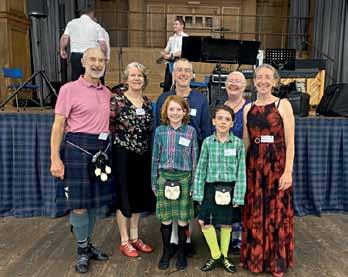
To accompany this year’s publication of RSCDS Book 54, the Society invited Fife-born Neil Galloway to make a recording with his band. Jeremy Hill, Membership Services Convenor, caught up with Neil and learned more about his background and interests in playing for Scottish country dancing.
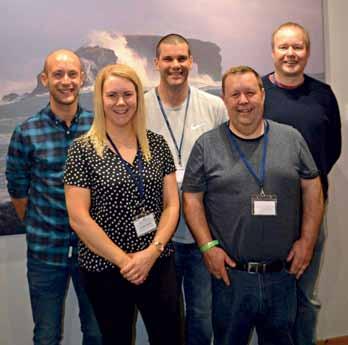
Gary Sutherland,second accordion;Susan Gordon,fiddle;Neil Galloway,lead accordion;IanAdamson,drums;Graham Berry,piano.
Family influences and the passing of the baton have played a big part in Scottish music history, from the fiddles and cellos of the Gows at the end of the eighteenth and beginning of the nineteenth centuries, to the accordion families of Jimmy Shand and his son Jimmy Junior in the twentieth, and, more recently, David Cunningham Senior and Junior into the twenty-first.
Neil Galloway’s father may have been more of a ‘play it around the house’ musician, but he wasn’t short of family influence, starting with his great-uncle Hector. Hector used to take his three-row accordion around the pubs and clubs of Ceres in the 1950s and 60s and was still playing in the family when Neil was growing up. Of even greater significance – as we will see – was his father’s cousin, the legendary Bobby Crowe.
Neil first picked up an accordion at home in Cupar at age four and started having lessons with David Cunningham Senior in the early 1980s, ultimately on the same accordion on which David Junior had learned. When David Senior stopped teaching to concentrate on his business, Neil started going to Mickie Ainsworth in Scone, formerly the second box in Ian Powrie’s band.
Through Mickie, Neil found himself engaged in many holiday and summer gigs. One such event was in Glenshee, where the cabaret demanded a wide range of jazz, classical, and Scottish music, though not for dancing. That strand of his musical development came from occasional jobs with Jimmy Shand Junior and Bobby Crowe – an amazing training ground for a young player!
While at school, Neil first had a chance to play with David Cunningham Junior and his school contemporary Graham Berry on piano, when, as a callow first year, he was plucked out of a maths lesson to join them playing at the end of term. When David’s band got going, with Graham on keyboard and David’s cousin, Ian Adamson, on drums, and he was looking for a second box player, it was natural that he turn to Neil.
This was in the mid-1990s, and Neil found himself busy with a whole range of playing engagements, often as many as six
nights a week, for dancing, hotels, shows, and cabarets, including invitations from as far as Shetland to play as a soloist. Having entered the Scottish Accordion Championships on and off over the years, starting as a Junior, recognition of his individual skill came in 2001 when he came away with the Senior prize.
Bobby Crowe was sadly forced to stop playing in the 1990s following a stroke, but Neil could carry on the tradition, playing Bobby’s Gola accordion, which he plans to use on the new Book 54 recording. Neil also inherited a lot of Bobby’s music.
At this time, Neil was also part of the Lomond Ceilidh Band, and he faced a decision when the rest of the band wanted to switch to playing full-time. As a qualified precision engineer, Neil saw the playing more as a side interest (albeit an important one), so, when a role came in the oil industry in Aberdeen, he stepped back significantly from playing. David Cunningham also cut back his playing for other commitments, which meant fewer band engagements.
In 2018, Neil took up David’s invitation to cover a slot at the Shetland Accordion and Fiddle Festival, which led to a few engagements for BBC Radio Shetland and then for the BBC in Glasgow. This was alongside solo playing that he could fit around his work. Though based in Auchtermuchty, he was often up in Aberdeen for work. He would get the band together for ceilidhs, reel clubs, and accordion and fiddle clubs when he could. As a soloist, he would still play for classes in Aberdeen and back in St Andrews and Ceres.
Since coming back ‘onshore’ in 2023, Neil has been busier with playing again, both with the band and solo. He was delighted to be able to take up the invitation to play at the RSCDS Summer School in St Andrews in 2024. He also enjoys playing regularly for a class in Dundee.
Musically, of course, he grew up hearing Bobby Crowe’s sound locally, but he also cites the influences of Lindsay Ross and Graham Mitchell; for other accordion styles, he was influenced by the great Jack Emblow. He also enjoyed the style of The Hamefarers Band from Shetland, which included Willie Hunter on fiddle, Jim Halcrow on accordion, and Ronnie Cooper on piano. He enjoys playing in this Shetland style, with a real focus on melody and rhythm.
Neil says he finds himself drawn to some of the ‘technical’ tunes, but enjoys a complete mix, bringing variety to all the different tempi through the choice of different tunes. He admits it took a while until he appreciated the beauty of the strathspey, but among his favourites now he mentions the great Skinner tunes, as well as the likes of The Gentleman and The Dean Brig of Edinburgh
He has always enjoyed researching and putting arrangements together and finding the ‘just’ tempo for country dancers – a more subtle requirement than the emphasis on speed you might get from a ceilidh band. It’s more about finding the lilt that makes for good dancing, which comes from a combination of phrasing and spacing – the gaps between the notes are as important as the joins between them.
For the new recording, Neil was finalising his band at the time of writing, but Graham Berry and Ian Adamson were inked in. Combined with Bobby Crowe’s box and the traditions in which Neil has been steeped, the resulting line-up promises an album that we all look forward enormously to hearing.
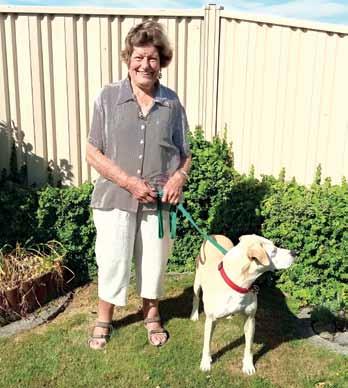
In September 1955, I was just 25 years old and from Cheshire, England, when I found myself in Sydney, Australia. We knew very little about this country on the other side of the world. My original idea was to visit for about three months, but it was promptly revised once I realised how vast the continent is! It was almost two years before I saw my beloved England again. I found a private board on the North Shore and a three-month secretarial job in a small city office. But how was I to get to know these Aussies? Of course! I was a Scottish country dancer – my ‘Second Family.’ Miss Milligan liked to refer to the RSCDS as a Worldwide Family – I was about to find out for myself just how wide! In the 1950s, SCD did not have the highly efficient organisation we have today, and it took me a while to track down a class. It is a wonderful feeling to walk into a room of strangers and almost immediately feel at home. No form-filling or other paperwork was required; it was “on with the shoes and on to the floor- and 1 2 3. and 2 2 3.” Sheer delight.
Fast forward three decades, and having raised a family of four, I was fortunate to fit in some overseas travel. I went to Japan on more than one occasion. Being on the dance floor with so many talented dancers was a delight. I do not speak Japanese, but with SCD, one doesn’t have to know the language; one can enjoy an evening out, wonderful fellowship, and sharing the joy of Scottish Country Dancing.
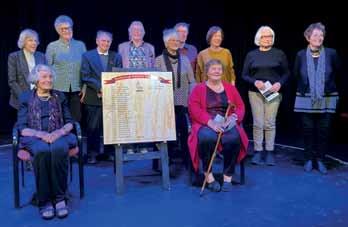
For many years, pre-COVID, I visited Britain every other year. I would finish these visits with a week at St Andrew’s Summer School. What an inspiring end to my visits!
Over the decades, I have lost count of the many people who have expressed the wish to have taken up SCD when they were much younger. I am always glad I did! Membership in the RSCDS provides a friendly, happy, worldwide family – one’s Second Family – and it doesn’t cost a fortune to become a member. We have a family of four children who came along with us and found themselves on the dance floor.
Thank you, Miss Milligan, for making all this happen. Your vision, the guidelines you set, and your worldwide promotion of this wonderful, sociable pastime, where age is no barrier – you are never too young or too old to participate in Scottish country dancing.
DorothyWilson,Australia
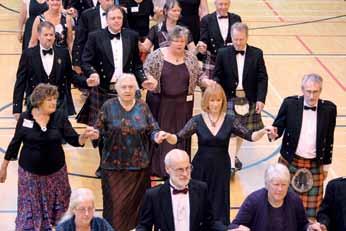

All branches and affiliated groups are invited to send in their news (maximum 200 words) to Caroline Brockbank caroline@ceilidhkids.com
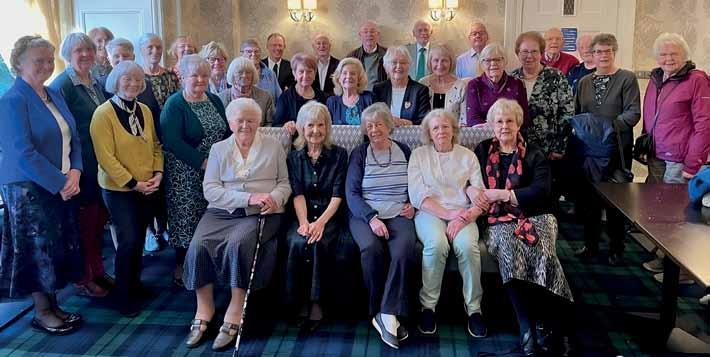
Seniors Silver Group.
In 1998 an afternoon tea was held in Glasgow to mark 75 years of the Society and of Glasgow Branch. Those attending were senior former dancers, plus a few still-active ones. They expressed a wish to keep meeting on a regular basis: to keep up friendships; and because they were still interested in Scottish country dancing – even if they could no longer participate in classes or dances. A Seniors

Anniversary
Group was arranged by Ruth Beattie, Joyce Turkington and the late Dorothy Paterson, which met for the first time on 10 October 1998. It has now evolved into four meetings per year, and all members of Glasgow Branch are welcome to attend. As well as lunch there is usually musical entertainment and/or a speaker.
The Seniors Group marked their Silver Anniversary on 10 October 2024, with a
Hamilton Ontario Branch celebrated our 70th Anniversary on Sunday, 8 December 2024, the closest we could plan to the date on our original letter of Branch confirmation. An anniversary party, with afternoon tea, was held at the Art Gallery of Hamilton, with over 90 guests in attendance. We are proud to be the first Canadian branch, and though no original members were in attendance, J’ina Middleton, member since 1957, chaired the party’s organizing committee. Many current and past members travelled several hours to get there, and hugs and greetings abounded. After tea, guests enjoyed a short programme of dances to the music of ‘Scotch and Soda’ (Laird Brown with Warren Beesley). Dances were chosen for their popularity in a specific decade, with Memory Lane (Gene Mackinnon) and My Friend Joe (Robert Campbell) included for their relevance to the branch.
special lunch (and, of course, cake!) organised by current leaders Maureen McCrudden and Maureen Daniel and musical entertainment from Eric Finley. The lunch was a suitable occasion on which to present Ruth Beattie with a Branch Award marking her service to the Branch and the Society. We look forward to our Golden Anniversary – and all the other meetings in between.
Ian Johnson
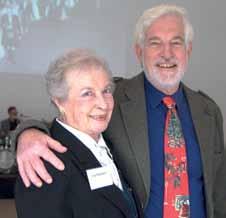
The RSCDS and Gary Coull sent congratulations, with a toast to another 70 years of fun, fitness and friendship. Eight Branch teachers bravely performed in front of their classes. Miss Jean Matheson (Leaflet Wiliam Clark 1959) honoured the first Branch teacher who died far too young in 1957; it is believed to be the first dance devised in Canada.

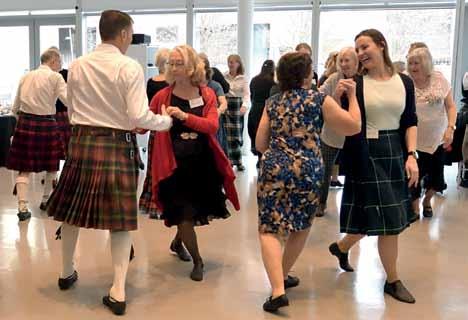

Tables displayed memorabilia, including silver trophies from competitive dancing days and T-shirts celebrating past events. One table honoured Branch members who had been awarded the Society’s Scroll; another remembered our 31 past chairmen over the 70 years. The event ended with The Duke of Perth, followed by an emotional Auld Lang Syne, each guest taking home a souvenir booklet of the Branch’s history.
Anne Harrison and Hugh Morrison.
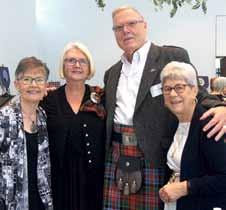
Formed in 1994, we currently have over 50 members. We cover a diverse geography from South Ribble to the Fylde coast and Clitheroe in the east of Lancashire, with most of our classes and dances being held in the Preston and Chorley areas, and we are known for our warm welcome and friendly dancers.
We celebrated our 30th Anniversary in several ways, such as reducing the price of all our dance tickets for the entire year, holding a Summer Dance with buffet supper, and a Halloween themed Autumn Dance, with special guests William and Linda Williamson. We were honoured to be one of William’s last events as Chairman. We also produced a small Anniversary Booklet to capture dances written by some of our members to ensure they don’t disappear, never to be danced again! Want to know more?
See our website www.rscdsribblevalley. org.uk
Sandra Lloyd
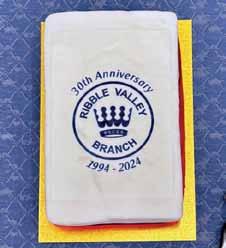

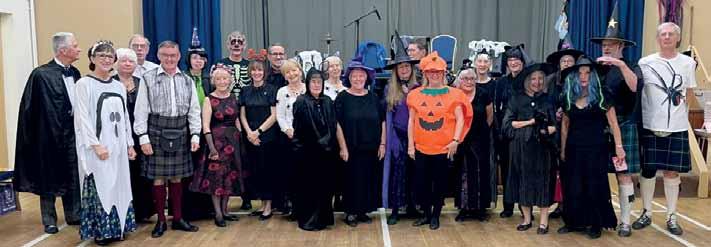
RibbleValley group.
st michael’s scottish Country Dancing Club – burns Night Dancing at Cooksons Court
Ten dancers from St Michael’s Scottish Country Dancing Club in West Camel, Somerset were invited to Cooksons Court care home in Yeovil on the morning of Burns’ night, to dance for the residents. One of the audience, Ann Hammond, was a founder member of St Michael’s Scottish Country Dancing Club over 40 years ago. Ann cast an experienced eye over the dancers while they performed four dances in front of about 40 residents and members of staff. On completion of the dancing the audience were treated to a rendition of Auld Lang Syne and then the Address to the Haggis. The dancers then spent some time chatting with the residents while haggis was served. The staff had gone to great lengths to decorate the area with Scottish flags and pictures of Robbie Burns, and made the dancers feel most welcome. The photographs include some of the team with Ann after the dancing was complete.
Gary Duffield



st michael’s scottish Country Dancing Club
On a cold February afternoon in Somerset, 60 dancers gathered for a Day School organised by St Michael’s Scottish Country Dancing Club at The Davis Hall in West Camel near Yeovil. Thirty Club members were joined by a further 30 dancers from as far afield as Bristol, Weymouth and Exeter and they all enjoyed a very educational and enjoyable session led by Simon Wales, who had travelled from Maidstone for the weekend. Music was provided by Ian and Judith Muir who had made the journey to ’The Big Island to the North’ from the Isle of Wight. This was the first Day School organised by St Michael’s and was the brainchild of the Chairperson, Maggie Westley. The feedback has been very positive and everyone appeared to have enjoyed the event. After the session was complete, most of the dancers remained for a delicious meal prepared by Graham and Liz Beckinsale ably assisted by several Club members. The day was completed with an evening dance where music was, once again, provided by Ian and Judith Muir and dances called by Andrew White. The Club meets every Thursday evening (except July and August) and welcomes new and visiting dancers.
www.stmichaelsscdclub.org
Gary Duffield
seattle branch
On November 23, 2024, the Seattle Branch celebrated the one-year anniversary of the RSCDS centennial by travelling around the world, without leaving the room, with Scottish country dances. Elinor Vandegrift and Elsie Spinning devised a delightful program of 11 dances, each from a different part of the world. Attendees were invited to dress in a costume from a country of their choice. In addition to the dancing, it was fun to hear what part of the world each dance came from, and those who dressed up discussed their costume.
Harry Khamis
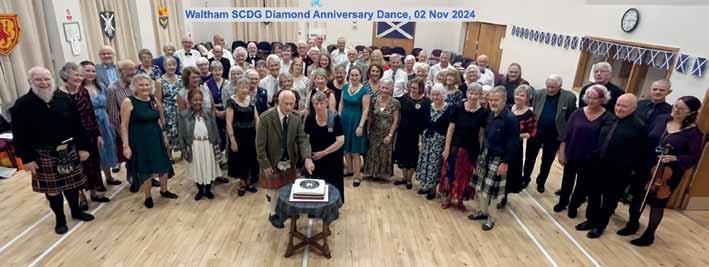
Founded in 1964, Waltham Scottish Country Dance Group celebrated its Diamond Anniversary at its Annual Dance in November. The dance was held in the village hall to the Craigellachie Band. It was a great treat when they came as a five-piece, with Ian and Judith, Graham and John, with Ali on fiddle – what a fantastic time we had!
The programme was devised with 1964 in mind, with dances popular when the group was formed. Many were new to more recent dancers, so class practices have included John McAlpin, Roaring Jelly, The Duchess Tree, Mrs Milne of Kinneff and more. A dance was devised for the occasion by Chris Ronald – The Waltham Diamond, a 32-bar strathspey for 4 couples in a square set; music had been adapted by Jim Lindsay from the song Diamonds are a Girl’s Best Friend, and the band played their interpretation of it along with music from other shows.
Tickets printed for the dance - 60 of course! – were all sold well ahead of the event, a cake was decorated with our newly designed logo, and all dancers were given a tartan shoebag, made by one of our members and embroidered with the new logo, as a memento of the evening.
John Aitken
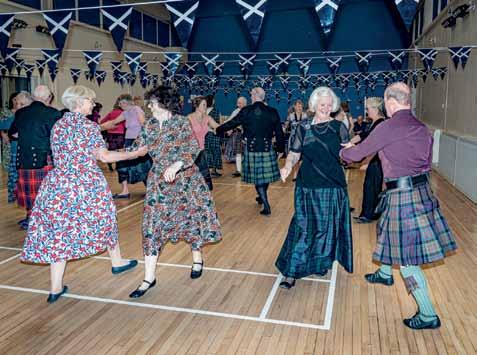
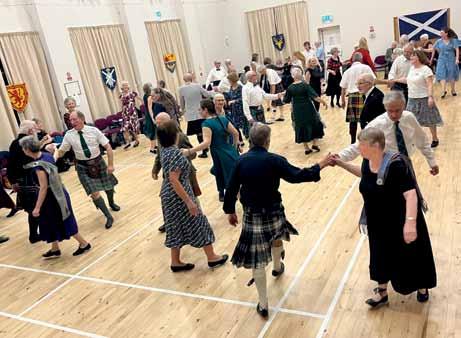
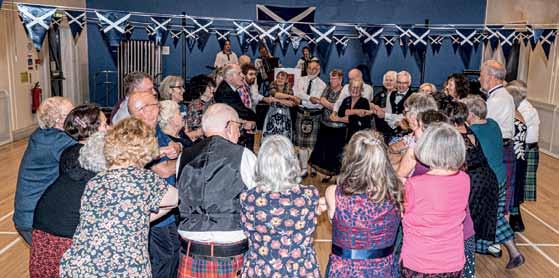

stone scottish Dancing Group 70th Anniversary ball
In October 2024, Stone Scottish Dancing Group proudly celebrated its 70th Anniversary with a ball and a buffet supper at Bradwell Lodge Community Centre in Newcastle-under-Lyme, and the occasion was a great success. We are a small group, so we were pleased to have 48 people attending the event. Many of our visitors said how much they
enjoyed the evening and commented on the venue (larger than our usual hall), the friendly atmosphere, the splendid buffet and the excellent musicians Chris, Julie and Nick Dewhurst. The programme of 21 dances included JB Milne, which was written in 1954, the year when our group was founded, and Heather’s Strathspey for three couples, an adaptation of a dance specially written for our 30th Anniversary Ball in 1984, for Heather
Davie, a former RSCDS trained teacher who has been a member of our group for longer than everyone else. We are delighted that she is still dancing and could join us for the ball. Our raffle for charity raised £160, a record amount for our group. A successful and thoroughly enjoyable evening, ending with us linking arms and singing the traditional Auld Lang Syne.
Chairperson: Dilys Riley.


28 December 2025 to 5 January 2026

Ilam, Christchurch, New Zealand
Bring your glad rags and enjoy a 1920s themed week of fun-filled dancing, music, and social events.

There will be a superb range of teachers and musicians: Our international guests are Linda Henderson (teacher) from USA and musicians Susan MacFadyen, Shona MacFadyen and Ewan Galloway from Scotland. Our New Zealand stars include teachers Doug Mills, Hazel Fish, Damon Collin, Helen Smythe, Diane Bradshaw, Iain Matcham and Ruth Budden, bolstered by a choice selection of New Zealand musicians.
A full range of classes are available for dancers and a Music Course led by Susan and Shona.
Registrations via Website: www.summerschool2025-26.co.nz
Organiser: Graeme Plank. Email: ss2025@dancescottish.org.nz


This newly published book contains a collection of 16 dances devised by present and former members of the Cheshire Branch to celebrate their 40th Anniversary. Robert Whitehead and the

The book features five reels, four jigs, and seven strathspeys, each accompanied by a crib. It features dances that suit all dancing abilities and cover a wide range of formations; many are familiar but presented in a different context. Formations included are set and rotate, a circulating allemande, reverse Schiehallion reels, tandem reels and Celtic reels, offering teachers the opportunity to pick dances to teach these particular formations. It is nice to see a wide range of dances with different forms of sets. Along with longwise sets, this book includes dances in square and triangular shapes, including three-couple and four-couple sets. The dances have a real diversity to keep all dancers happy and would be welcome on any dance programme.
The music is recorded on CD. It is upbeat and very easy to listen to. Robert Whitehead has included an excellent mix of tunes from the past and present, by accomplished musicians such as Angus Fitchet, Jimmy Shand, Donald Ridley, Adam Rennie, Jim Johnstone, Ronnie Cooper, and Ian Holmes. Many very danceable tunes support the originals. It had my feet tapping on many occasions. The strathspey tunes, in particular, reflect the influence of past composers and dance leaders, while there are also new, upbeat tunes to keep us all interested. The music will delight dancers of all kinds.
The book is beautifully presented, and the dances are easy to read. It will be a great asset to any dance teacher and will enhance anyone’s library of dance books and music.
Jim Stott

Illustration taken from the Glasgow Life website.


It all started with Catherine, one of our adult dancers, asking if I could do more to help them avoid getting lost when dancing away from home for an evening dance or an SCD weekend.
I was used to teaching in French, but I also used the SCD vocabulary. Some words can’t be translated, but dancing away or abroad makes it easier for dancers to understand what’s going on, as they already know some key dance terms. So, I use SET even if, in French, we hear ‘«SEPT»’, which means seven. Allemande and Pas de Basque are obviously easy for us! But, I also speak about Rights and Lefts, although it would be easier to say Chaîne à 4…
What more could I do? Teach more formations? Teaching formations using the evening dance programmes where my dancers had registered was another option. But, it became increasingly complex to satisfy them, as they don’t always register for the same events.
This year, I chose to give them all compulsory Pillings lessons: one dance from each class was taught from diagrams. During the first class, I would teach the main formation, explain the dance, say general things about it, then give the dancers the diagram and ask them to do the recap. The next week, I would give them either a diagram of the dance taught previously or a diagram of a new dance that has almost the same symbols and ask the class to explain the dance. They were in small groups, debating for five minutes about what they thought was the dance and then, all together, they would try to explain the dance. It wasn’t easy at first, but then all the adults got caught up in the game. I heard many funny remarks, of course! Stop Sophie! I need my glasses! So do I!
At other times, they looked at the symbol ‘D’. What could this mean? What on earth is that dance? What can we be doing starting with the letter D in English?
At the end of the year, I heard more questions about details: How do you know who is dancing? Why do all couples now have an ‘x’ next to their number? It was fascinating, and they loved each
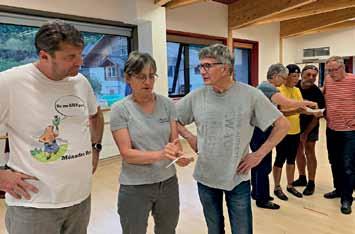
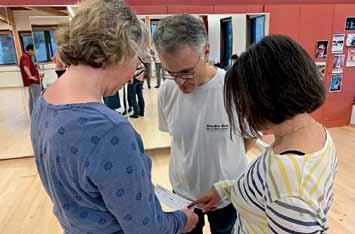
class’s ‘Pilling dance’ routine. The Pilling dance was not always the first dance taught. It would depend on the symbols used or the difficulty of the dance. It worked so well that I decided from this January onwards to use the same teaching style with the children’s class. They were even quicker than the adults to understand and cope with all the symbols!

I was teaching Bit of Both and asked the class; What’s the name of the dance? How many couples will be dancing? Would they be dancing: square or longwise set?
Nina, nine years old, was waiting with her hand up to reply. Reading quickly, she then replied very seriously: ‘The first three couples start having SEX for 4 bars, then I don’t know what they are doing, but they end up going for a promenade.’ Of course, I couldn’t stop laughing! Indeed, a cross (in French, ‘«croix»’) is not an obvious way for French people to think of crossing ‘«traverser»’; it doesn’t sound the same at all.
The next step for this coming year is for the dancers to draw their diagrams for the first-week dance and then review them. In the second week, look at the diagram and ask the dancers to explain the dance. Third week: dance and then have the dancers draw the diagram of what they have (or should have) danced.
Gilbert, one of our adult dancers, started drawing his own diagrams. We created a few dances this year, and when Keith Rose sent us his diagrams, it was great to check if Gilbert was right or not!
SCD is not only a matter of steps and legs! The brain does the central part. Even if what really matters is the smile on every dancer’s face at the end of the class.
One of the joys of Scottish country dancing is that it is available worldwide, and the terminology is universal so that you can travel to many places and still do the dancing with which you are familiar. Another advantage is that it is an open community – welcoming to all who want to participate. Any changes to SCD should be made with the goal of meeting the needs of as many dancers as possible.
The current trend in some areas of the US to teach and brief Scottish Country dances with non-gender-specific terms for the dancers is a concern for me and others, and I want to express my opinion on what I see happening. Please understand I have no objection to people who prefer not to be assigned to a gender, and I fully support having an open and welcoming dance community. I am concerned that dance groups are splitting into different approaches to teaching SCD, making it less universal and potentially alienating existing dancers who are unfamiliar with the new terminology. Also, I’d not like to see us end up changing 100 years of tradition without first trying to preserve it in a way that works for everyone.
I know of two variations of non-gender-specific terms in use (there may be others I am not familiar with), and I believe both have issues. The one used by some groups in my area refers to the traditional men’s side as the left side (and the dancers as some variant of a left-side dancer) and the traditional women’s side as the right side (and the dancers as some variant of a right-side dancer). This references the shoulder that is toward the top of the set when dancing. Superficially, this seems like a good thing, but I see two major issues with this: 1) there are already many figures in SCD that use right and left, so it can be very confusing to use right and left to refer to a dancer and to a figure and 2) this can be difficult for dancers who are already right/left challenged.
The other variation is essentially an extension of the right/left designation, adding another level of translation to determine who you are. People use the terms ‘lark’ for men and ‘robin’ for women, using the starting letter to indicate the shoulder pointing toward the top of the set. This is even worse, as one now has to understand right/left and then translate it to lark/ robin. Additionally, this does not apply to languages spoken in non-English speaking countries.
Since Scottish Country dancing is a worldwide tradition, any non-gender-specific terminology should work in all countries. In non-English-speaking countries, the terms ‘men’ and ‘women’ are positional and don’t assume any specific gender. I wish this were acceptable in the US, but apparently, there is a move by some to no longer refer to anyone as a man or woman while dancing.
Perhaps the Society should consider setting some norms for non-gender-specific dancing that could be used universally. (It would be helpful to know how many dancers this would apply to, how many non-gender-specific dancers have objected to
the current system, and/or how many dancers are leaving due to the change versus how many we are attracting.) I have a modest suggestion should the RSCDS decide to recommend or adopt non-gender-specific terms in place of men and women. We already have diagrams that, many thanks to the people who generate them, exist for nearly every dance out there. Why not refer to people on the traditional men’s side as circles and those on the traditional women’s side as squares? That matches up with the diagrams, carries no gender designation whatsoever, and requires no major disruption to SCD.
If the Society decides to select new terms, a major consideration is what will happen to all the existing books that use ‘men’ and ‘women’? For teachers and readers of existing written materials (dance books, The Manual, etc.), there is a need to translate to the non-gender-specific term, making lesson preparation and teaching more difficult. Since the official books contain both written words using men and women and diagrams using circles and squares, there would be no need to rewrite or reissue the books. Classes could use whichever designation they prefer, but they would need to explain the other usage.
Sue McKinnell, Chicago Branch

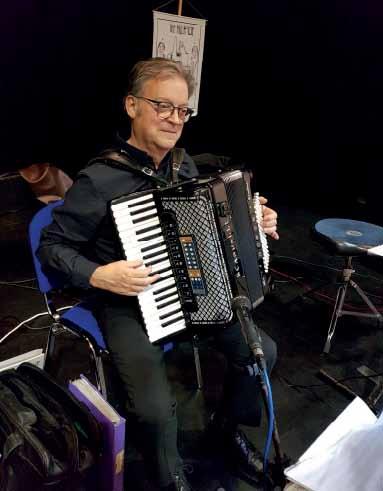
On Monday, 27 January, Ian Muir from Prestwick in Ayrshire was the musician for the Scottish country dance section of the Inverclyde Music Festival, held in the magnificent setting of Greenock Town Hall. The prescribed dances for Primary 6 and 7 were The White Cockade or The Edinburgh Toy Shop Ian Muir. Greenock.
Remarkably, every team chose The White Cockade! With a total of 14 teams of children entering, Ian had to play the full dance eight times, never once repeating a set. This meant a total of 112 times. He played the named tune, The White Cockade, at the beginning and end for each team = 28 times –plus 42 alternative tunes. It took almost an hour and a half. The standard of dancing was very high, and the winning team with 96 points was St Mary’s Catholic Primary School, Greenock. With 112 children in this one section, the balcony filled with parents, the atmosphere was electric. When I announced the winner, the cheers were deafening!
Ian played for every competition from 10 in the morning till 7.30 in the evening. A total of 10 primary schools took part, almost half of all the schools in the Greenock, Port Glasgow and Gourock areas. Most of the classes were competitive, but there were also non-competitive sections for children who had never competed before and for teachers with little experience of teaching Scottish country dancing. One highlight for me was the team of children with special needs, who danced their dance perfectly and counted one to eight aloud for each formation!
The Inverclyde Festival lasts for two weeks, using three different venues, with a total of 11 adjudicators. As well as Scottish country dancing, the competitions include choir and solo singing, Scots fiddle, clarsach, accordion, solo and duet instrumental, opera, Gilbert and Sullivan, drumming, storytelling, recitation, Burns song, school orchestra, chanter and bagpipe, all finishing with a grand concert on the final day.
Jimmie Hill,Adjudicator.

Fifty-eight dancers, two teachers, and four musicians arrived at University College on the afternoon of the 22 November to attend the Southern Fling/Fringe 2024 weekend. This was a new venture for the Melbourne & District Branch, replacing our annual Branch teaching weekend and incorporating the Spring Fling weekend for younger dancers, held on a biennial basis down under. We welcomed dancers from across Australia and New Zealand. Sixteen young dancers comprised the Fling class, and thirty-two danced in the Fringe class.
The weekend coincided with the RSCDS Dance Around the World, so all the dances on that program were blended across the weekend in classes and the Saturday night social.
Clare Haack and Andrina Brennan from Sydney were our two teachers. Clare taught the Fling class and Andrina the Fringe class. We were very lucky to have such enthusiastic and friendly teachers join us for the weekend.
Matthew Robertson, Duncan Smith, David South, and Pip Healy played wonderful music for classes and the social. On Friday night, Matthew and Duncan led us through a ‘Ceilidh Around the World’ (keeping to the Dance Around the World theme) that included English, Irish, and Contra dances.

Bishop’s University Sherbrooke, Quebec
For dancers of all levels Partial week attendance options
Teaching Staff
Rebecca Blackhall -Peters, BC Canada
Linda Henderson, California USA
Andrew Nolan, UK
Cecily Selling, Pennsylvania USA
Music Director Gary Thomas, California USA

Highlights – the whole weekend, but, in particular:
l The Fling class presented TheWild Geese as a demonstration dance at the Saturday night social.
l The debut of Jig for Liam – Time Traveller was played at the social. This is a jig that Matthew wrote for David’s son, Liam, who has had some medical challenges lately. All those attending the weekend sent a special message to Liam to wish him well on his journey to good health.
l Hannah Duque, one of the Fling dancers from Sydney, joined the band to play some of the dances at the social.
Accommodations, meals, classes, and the social were held at the College, bringing the Southern Fling and Southern Fringe participants together in a cohesive and communal atmosphere. Old friends were reunited, and new friends were made!
We acknowledge the RSCDS Jean Milligan Fund for providing scholarships, both full and part, to four of the younger dancers, the Sydney Branch for providing scholarships to two of their dancers, and all those who donated funds to enable the Melbourne Branch to award sponsorships to all the students who attended the weekend.
Christine Freeman, Southern Fling/Fringe 2024 Convenor Melbourne & District Branch Inc
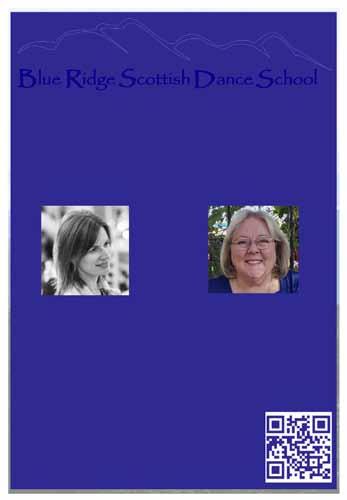

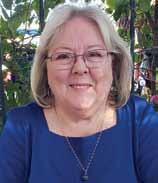
Any opinions expressed in the letters below are personal to the writers and do not reflect the views of the rsCDs or the management board
Dear Editor
Terminological Inexactitude
I have been dancing many a year and have listened to many a dance description given from many an experienced MC. This is just a plea to all MCs to watch their terminology.
Is it lead down the middle and back up or simply up? Back up certainly implies using a retiring step. Then, there is the use of the wrong side as opposed to the opposite side. Surely, there is never a wrong side only a correct side? To set is two bars so to ask dancers to set to the right and set to the left suggests 4 bars and to say the least can be confusing. It would be more correct to say pdb to the right and pdb to the left. This would usually apply when the second pdb is required to move on that step (same applies to strathspey setting steps).
SCD can seem confusing to dancers, so it is important to mitigate this with clear consistent unambiguous calling. I wonder if my plea will fall on deaf ears?
StephenWebb,London Branch
Dear Editor
Unlike Fiona Bullivant (Letters to the Editor, Scottish Country Dancer, no. 39, October 2024), I was delighted (and relieved) when the RSCDS released their Guide to Etiquette (Code of Behaviour) as part of their Safer Places Initiative. I congratulate the Society on its courage in formulating and promoting a code of behaviour that reflects 21st-century expectations.
I’m pleased that under the new guidelines ‘it’s okay to say no’. I found the convention distasteful that by rejecting an invitation to dance I was obliged to sit out while the recipient could ask someone else to dance. I felt penalised for exercising my right to decide with whom I would dance.
When proposing to dance with another woman, I welcome the freedom that I can now say no to a request that we separate so that two men who don’t want to dance together can each dance with a woman.
As inappropriate behaviour can occur both on and off the dance floor, the code quite correctly acknowledges a person’s right to cease dancing at any time. No one should be obliged to continue dancing if they feel uncomfortable as a result of a fellow dancer’s words or actions.
The above examples show how outmoded conventions detract from the enjoyment of dancing as an inclusive social activity in contemporary society.
As a relative newcomer to Scottish country dancing, I have continued to dance even after having been pushed, pulled and yelled at by both teachers and fellow dancers. Unsolicited verbal and physical guidance when I make a mistake is off-putting and borders on intimidation. As with most dancers, I am (usually) aware of when I make a mistake and do not need to be castigated or corrected by fellow dancers. I agree with the new code of conduct that correcting mistakes is the teacher’s role. If a set should ‘collapse’ as a result of my error, I believe the ability to recover is part of a dancer’s ‘toolbox’. As an experiential learner, I also believe that making mistakes in a supportive environment is an excellent way to learn.
Acknowledging and supporting an individual’s rights is essential
for the future of SCD. A dancer who has an unpleasant experience typically does not return to the club. As the number of SCD dancers is declining, the new etiquette guidelines will help arrest this decline if they are adopted by SCD clubs worldwide.
No one wants to attend a social activity where you are intimidated by those who consider themselves more experienced than you and believe they have the right to direct your actions.
Jo Ferguson,Canberra and District Branch (Australia)
Dear Editor
In response to Fiona Bullivant’s Letter to the Editor in the October 2024 issue, nothing in the Etiquette Guidelines prevents the majority of dancers from behaving exactly as they already do; the option of accepting a dance from someone they’d rather not dance with for fear of offending them remains available. What they do offer, however, is a valuable protection for any dancer who might need that fallback to avoid an uncomfortable or unwanted experience. Let’s use these guidelines sensibly to ensure the dance floor is comfortable for everyone.
Andrew Nolan,Edinburgh Branch
Dear Editor
Regarding Fiona Bullivant’s letter in Scottish Country Dancer 39, there are some situations where one could justify refusing one partner and then accepting another
l If the first to ask is drunk or otherwise offensive.
l If a beginner is asking for a complicated dance which beginners have been asked to sit out.
l If you want to sit out a dance but one more couple is needed to make up a set, refusing may cause several people to have to sit down.
Elizabeth Bennett,Croydon/London Branches
Dear Editor
At the 2024 AGM, the Society delegates voted in favour of the Management Board’s motion to change the Chair-Elect / Chair terms of office from two years as Chair-Elect followed by two years as Chair to one year as Chair-Elect and three years as Chair. The justification was that two years as Chair was too short. This is a significant change that I would have thought merited wider discussion. A three-year term for the position of Chair may sound sensible, but it does expose future Chairs to being in post with no Chair-Elect to share ideas and offer support.
The idea behind this change came from the Board, and yet, in his outgoing address, the retiring Chair thanked the incoming Chair and stated, ‘Gary and I have simply been a team’. He continued, ‘We both realised that moving the Society forward required two heads’and‘wehaveworkedtogetherforthegoodoftheSociety’. The irony of the outgoing Chair’s address was not lost on some of those present – the AGM had just passed a motion that denies future Chairmen the benefit of working closely with their ChairElect for the first two years of their three-year term! How weird! Now I hope this change works for the best, but I feel that taking on the role of Chair after only one year as Chair-Elect and with no support from the next Chair-Elect will be a challenge.
The Autumn Gathering was also an opportunity to look forward and discuss where the Society is going. Membership is significantly
lower than it was 20 years ago, and in Scotland and the rest of the UK, it is in decline relative to the rest of the world. If this trend continues, the future looks a bit bleak. For a meaningful future, the Society must focus on strengthening its Scottish base. Now, you might expect that this would be a high priority and subject of discussion at the weekend – but no, discussion forums were sadly lacking. However, we ought to encourage discussion to share ideas and engage with others. Let’s update and resurrect the Open Forum and schedule it for a more sensible ‘mainstream’ time. Members’ views are important, and the Society should not fear them but encourage members to express their thoughts. We can only grow and reverse the decline if we share ideas and answer the question: ‘What should a 21st century RSCDS look like?
Peter Knapman,Glasgow Branch.
Dear Editor
A few thoughts!
1. Music and dancing are part of Scottish culture, but what the Society does seems to be something different and not as danced in Scotland! Should we not be putting our heads over the parapet and having a look around and perhaps becoming more involved, e.g. at Reel/Gillie Balls, in Celtic Connections, Linlithgow Scotch Hop, etc? We still do not have dancing in Scottish schools, perhaps because schoolteachers are not impressed by what they see. Does our Youth Services committee have enough input?
2. I expect us to elect a Chairperson that can hit the ground running and be full of ideas etc. and be fit to manage rather than teach. I am not happy with the new 3-year term of office,

which we had before, and think we should be looking at how and who is up for election: I do realise that the Society is a difficult, worldwide organisation!
3. Most years the order of the AGM agenda is not correct but it never seems to be noticed. We also have a constitutional committee but only for Branches: what about the rest of the Society? Very strange.
4. I still cringe at the Society failing to make use of the opportunities of its 100th anniversary and in particular the Autumn Gathering in Glasgow. I think Autumn Gathering requires some new ideas, a director, and a choice of dancing. I also believe having an overseas branch producing an AGM dance programme for Scotland undermines dancing in Scotland.
5. I hope the Board will rise up above the trivia and look at principles and give direction to its associated committees. I would, for example, question what the aims and objectives of teaching are and wonder why we allowed the introduction of so many new and often strange foreign dances: look where we are now! Thousands of new dances but a falling membership.
6. Dancing is supposed to be fun and friendly, but I look at Christmas Dance programmes, for example, and the programmes seem rather serious and not much fun and have nothing for any friends and family you may wish to bring along to try dancing.
From a management point of view, it is time we tried a few new ideas even if we get it wrong!
John Carswell,West Lothian

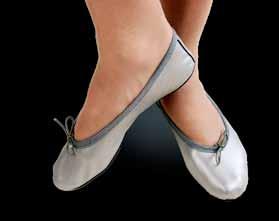
reel deal since 1954
For 60 years James Senior has been leading the way with our extensive range of Scottish Country and Highland dance footwear. Classic styling married with high-tech full-forefoot in-built shock absorption* ensures you can look the part without getting jiggered.
* James Senior was the first to develop a completely integrated shock absorption system, medically proven to protect the metatarsal area and minimise the risk of injuries associated with Scottish dancing.
Tel: 01334 880545 Email: sales@jamessenior.co.uk

We would appreciate it if obituaries (max. 150 words) are submitted by branch or club secretaries.
Edith Campbell
Edith gave over 60 years to Scottish country dancing in New Zealand, teaching at many national and regional events and at all levels, training teams for demonstrations, and serving on the organizing committees for several major occasions. With her husband Bruce, Edith established the Seatoun Club, where she taught for over 46 years. She served continuously on the Wellington Region Committee since at least 2002. In 2023, the Wellington Region gave her an appreciation award. Edith was heavily involved in promoting all things Scottish, especially through her efforts in the Scottish Interest Group she founded; playing her harp at many events; providing the calligraphy for the 60th celebrations; and through her many writings, especially in her column The SpurtleWielder, continuously in Harbour City Happenings since 1993. She had an encyclopaedic knowledge of things Scottish, and a generous spirit.
Rod Downey, President,Wellington RSCDS
rosemary Coupe
Rosemary was born in Tasmania, of Scottish descent, coming to Vancouver under the Commonwealth Scholarship plan. Hugh Thurston was her first SCD teacher, and Rosemary credited his expertise in dance history as a strong influence on her. Rosemary and Robert Coupe enjoyed mountaineering, camping and hiking. She taught English at Capilano College and was the founding Convenor of the Writing Centre. In 1990, Rosemary obtained her RSCDS teaching certificate. She taught until December 2022 and led the Burnaby Entertainment Team. She was a member of both the Vancouver Branch demonstration team and Barbara Campbell’s Inverary Dancers. Historical research was a passion, and Rosemary published the definitive article on the history of the Eightsome Reel. She produced a wonderful book on the history of SCD in Vancouver, as well as numerous articles on dance history. She was the founding editor of the White Cockade newsletter, editor of Scottish Country Dancer, and worked on The Manual.
Cathrine Conings,Vancouver Branch
s arah Garrett, h ertfordshire
Sarah was introduced to Scottish dancing during her school days by her brother, who took her to the Cambridge University class, where she met her future husband, Colin. By 17, she was playing the accordion for dancing, and the role of band pianist followed shortly afterwards. Together, they danced for Miss Milligan at St Andrews. Sarah played for Colin’s classes across the UK and North America, including Pinewoods. She was once on the music staff at St Andrews, as well as playing for ballet and tap classes and accompanying local singers. She was a life member of the RSCDS and belonged for many years to Berkhamsted Strathspey and Reel Club where she both danced and played. Her tune The Hyperactive Reel, for the dance co-authored by her daughter Jill, has been published by the RSCDS. Many times daily she had to ‘let out a tune’, sitting at the piano and improvising.
Marion Peutherer, Sarah’s daughter
Avis h arrison, l eeds
Members of Leeds Branch were saddened to hear of the death of Avis Harrison. She began Scottish country dancing in her twenties and gained her RSCDS Teacher’s Certificate in 1968 with Jean Milligan examining her. In 1964, Avis set up her class
at St Columba’s, Leeds, which she ran for 50 years until she was 80. She was well-known in Leeds as a branch class teacher and internationally as a teacher of country and step dancing. Avis was instrumental in organising many overseas visits for the Leeds Branch. She taught at the RSCDS Summer School for many years and travelled the world, demonstrating and teaching dancing. Avis travelled to Australia on a number of occasions and made many friends there amongst the Scottish dance fraternity. She was awarded the Society’s Scroll of Honour in 2006.
Kathryn Slater, Leeds Branch
Doris m cCutcheon
Doris began dancing at a very young age, under the tutelage of Bill Little. Once, Miss Milligan, giving a class, said, “Where’s my friend from Castle Douglas?” – she wanted 13-year-old Doris to show how to do a particular formation. Doris was selected, aged 19, for the International [demonstration] Team under Miss Milligan’s leadership. She took pride in the fact that, on that occasion, she was the only one unanimously chosen by the panel. She admitted that, while she was on the team, it was the only part of dancing she cared about; later in life, she “just wanted to dance” and did, in fact, do so until a week before she died. When Doris married Milne, the local newspaper referred to her as a famous local dancer. In 1978, she took over the teaching of the local authority class in Penwortham, Lancashire. From 1986, she also taught the advanced class at Southport Branch.
Stephen Brown, RibbleValley RSCDS
Anthony (Tony) Payne
Tony died at home of oesophageal cancer on New Year’s Day. His dancing career began locally in Eltham, continuing at Cambridge. Graduating there in Classics he taught at Blundell’s School, Tiverton, gained his Full SCD Certificate and co-founded RSCDS Exeter. Through dancing he met Dilys, a pharmaceutical chemist from Wrexham. Tony moved to Loughborough Grammar School and they married in 1974. Joining Nottingham Branch, Tony became its principal teacher, taking us with expertise and good humour through everything from 18th-century pure figures to McNab’s Lamont of Inveryne. His musicianship at piano and organ, his work with the school’s Naval CCF and his Christian faith as U.R.C. Elder and Street Pastor are remembered with affection and admiration. Nottingham Branch website carries a full tribute.
David Page
Neville r amsay
Neville Ramsay passed away in November at the age of 99, attending dances until just three years ago. During his dancing life Neville was a member of Ayr and North Ayrshire Branches and danced in demonstration teams at festivals and overseas. Neville was a true gentleman and is missed at dances in Ayrshire, although we were delighted he was able to join us and cut the cake at our Joint Ayrshire Branches Centenary Dance in 2023. He supported dances and events organised by all three Ayrshire Branches. Scottish country dancing was an important part of his life. He helped out in schools preparing for days of dance and festivals as well as organising a team to dance at his church for their annual Burns Supper.
Wilma Brown,Ayr Branch
John renton
John, who lived in a remote farmhouse in Inveraray, was a very accomplished accordionist and band leader with several RSCDS recordings to his name. He played strict tempo and like many other musicians loved seeing the pleasure on dancers’ faces when he played. Besides his playing excellence he was also a composer of many lovely tunes in the Scottish idiom; he passed some 1500 sets on to a fellow musician and friend when he realised due to arthritis he could no longer play. Tunes were always in his head and when recalling one he would simply sing/ hum it; it was a wonderful skill. John particularly enjoyed playing strathspeys, which he interpreted so well. He was a very talented Scot, modest, kind and genuine, and I have always felt privileged to have known him.
StephenWebb, London Branch
Catherine roy
No one remembers when Catherine started dancing but very quickly she was proficient and very enthusiastic, being Chairperson of both RSCDS Clackmannanshire Branch and Dollar class as well as Treasurer of Martice SCDC. Catherine loved to travel to dance and could be seen at Helensburgh, Oban, Duns, Perth, Troon and Dunfermline as well as in her home territory of Alva and Bridge of Allan and a friend’s garden in Alloa as soon as lockdown allowed us to meet outside. She loved nothing better than a foreign dance trip, going to Budapest twice, Cyprus, and lastly to Bologna. She was a member of the International Branch. Wherever she danced, she readily made new friends. Her slight figure was in contrast to her huge influence and ability. She had great wisdom and worked hard to help others enjoy dancing.
Lorna Anderson, Clackmannanshire Branch
Anne Taylor
Anne was originally from Edinburgh. I first met her in the 1960s when she attended an evening of Scottish country dancing in Forres, having moved from Stornoway. She had concentrated on Highland dancing and was eager to learn more about country dancing. Anne joined my class in Elgin, and the RSCDS, attending Summer School several times until marriage and twin girls came along. Once the girls were older, Anne returned to St Andrews to work for her Teaching Certificate, after which she taught classes in the local area, and served as Secretary of Banffshire Branch. She became an Adjudicator then was appointed Examiner. She was at her happiest tutoring candidates at all Unit levels. Anne was Director of both Summer and Winter Schools and was Convener of Education and Training until ill health forced her to resign. She fought her illness with great courage

and dignity, still attending dance functions as a spectator, most recently the 2024 Autumn Gathering. Anne will be remembered for the reel BroadfordBay,adopted by the Society in 2001; its name was inspired by the bay on Skye, where Anne, along with her husband Bob, spent many happy walking holidays. Anne was presented with the Society Scroll of Honour in 2022.
JenniferWilson MBE, Banffshire Branch
b arbara Taylor, Toronto
Barbara (Bilawey) Taylor grew up in Alberta and moved with her young family to Ontario in the late 1980s where she was introduced to Scottish country dancing. She danced for many years in Jean Hamilton’s Erin Mills class and in demonstrations in the Toronto area.
Barbara gained her Teaching certificate in 1999 and was a patient and gifted teacher as well as a graceful dancer. She taught a local class for many years, Toronto Branch classes and day workshops. She also served on several committees, including the Toronto Teachers’ Panel.
Barbara and husband Michael danced internationally. Barbara attended several TAC and RSCDS St Andrews Summer Schools, where she was selected to dance on one of the demonstration teams and was videoed performing dances from RSCDS Book 50 Barbara is much missed by family, friends and a world-wide community of dancers.
Keith & Deirdre MacCuish Bark and Helen Bibic.
m argaret Zadworny






It is with deep regret that we announce the passing of Margaret Zadworny, a lifelong member of the RSCDS. Margaret lived in many places across Canada, where she left a lasting impact on the Scottish country dance community. Margaret earned her full teaching certificate in 1967 and went on to teach Scottish country and ladies’ step dancing, as well as leading numerous workshops for both adults and children. She also tutored countless aspiring dance teachers, sharing her expertise and passion for dance. A talented and creative choreographer, Margaret was widely respected around the world for the original AyeAfloat and The Smitty are a testament to her remarkable contributions to the dance community. Margaret will be deeply missed by all who were fortunate enough to be mentored by her and to experience the joy of dance that she so generously shared.








All of Rosie Dickson’s charming and enthusiastic recommendations about SCD are already well-known to readers of this magazine. This was written for the U3A magazine and could be used by any branch or club seeking new members. The University of the Third Age (U3A) is an international movement that aims to educate and stimulate mainly retired members of the community in their third ‘age’ of life.Ed.
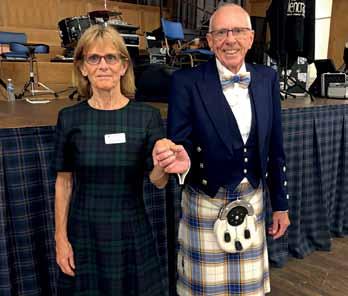
If someone had suggested a few years ago that my husband, Graeme, and I would be partaking in Scottish country dancing, I would have readily eaten my hat! Although I was forced into ballet and learning several musical instruments as a child, that was very much left in the distant past, never to be rekindled, or so I thought. As for G, well, frankly, he was the most unmusical, uncoordinated person I have ever met. However, following a trip to Glen Coe at New Year with a walking group, all that was about to change. As per tradition, the place we were staying brought in the New Year with vigour, and it was here that we first experienced Scottish country dancing, or to be more precise, our first-ever ceilidh. And, most unexpectedly, we loved it!
Upon our return to Dorset, we wondered whether there were any SCD clubs or classes nearby. We were to learn that you could dance practically every day of the week in South Dorset!
We enrolled with Dorchester U3A (University of the Third Age), where it all began. We initially had a class of about 16 people. The class was once a fortnight, which meant enough time passed between each class for us to forget everything we had learnt. After much enthusiasm from the group, the lessons soon became weekly, which was a big help! Although SCD can be quite physical, I think it’s worth mentioning here that dancing can be equally enjoyable and indeed acceptable, even if mobility is restricted, by simply walking through the dances. Our teacher, Irene, was and is incredible; she has the patience of a saint and deserves a chest full of medals. I’m sure she sometimes goes home after class, sits in a dark room, and cries!
The thing about SCD is that there is just so much to learn. I don’t want to put you off, but these are some of the facts. There are the basic steps, which initially seem impossible to get your head around. The formations are numerous, and even today, nearly three years on, they keep surprising us. The rhythms consist of jigs and reels, both of which are lively and energetic. There is also the strathspey, slow and elegant, yet equally demanding; there is nowhere to hide in a strathspey. The dances are performed with a partner and within a team of other dancers, but the good thing about it is you don’t need to arrive with anyone. Everyone dances with everyone else, making it an exceedingly sociable event with the more experienced dancers gently guiding the newcomers through the dance. And the feeling when a dance goes well is unbelievable!
That sounds very stressful and daunting, so why would you do it?
SCD offers so much joy and so many benefits. Firstly, it’s fun, and the laughs that have been had are like a breath of fresh air. It lifts morale, reduces stress and is an incredibly sociable experience. The physical benefits make it feel like a workout, but it’s much more enjoyable than going to the gym. Although it isn’t like a gruelling HITT (high-intensity interval training) class, SCD has been shown to have similarly positive effects on bone health. It involves weightbearing and moderate-impact exercises, such as hops and jumps. The dance form also involves muscle-strengthening exercises that are important for maintaining bone density, which can help strengthen bones and reduce the risk of osteoporosis.
This type of physical dancing improves cardiovascular health and brain function. It provides mental stimulation and socialisation, both of which are important for overall brain health. The memory and coordination required to learn and perform the steps can also help cognitive abilities. They say that practice makes perfect, but this takes time. When we first started dancing, we barely knew our own names by the end of a session, let alone remember the dance steps, so perseverance is key.
We’ve been dancing for nearly three years now, and not only do we attend sessions with U3A, but we also take lessons in Weymouth (Weymouth Scottish Country Dancers) and Charminster. Although initially nerve-racking, we’ve attended a few balls, which is a wonderful experience. The ladies tend to get dressed in smart or glamorous clothes, and the men often wear kilts and Bonnie Prince Charlie jackets. It’s a special sight, with everyone dancing in long lines. This is even more spectacular when accompanied by a hugely talented live band and performed on a sprung floor. A sprung floor is not something l had ever encountered, but the first time I did, it was like being on a trampoline; suddenly, little hops and jumps were transformed into something I would expect to do on a pogo stick! It is a thoroughly fantastic and magical experience.
There are also opportunities to dance on weekends and holidays, where very experienced visiting teachers offer lessons during the day. Then, in the evening, dances are held, often consolidating moves learnt during the day. These events frequently occur all around the country and the world. You will often meet familiar faces from previous trips.
A trip that we have found particularly special is the Royal Scottish Country Dancing Society (RSCDS) Summer School, held annually in July and August in Scotland - an action-packed four weeks of dancing at the University in the historic town of St Andrews. Dancers of all ages come from every corner of the world and are led by some of the best Scottish Country dance teachers, accompanied by brilliant musicians. We go for just one week (each week can vary slightly in content), and we have found that this is a fantastic opportunity to improve our skills. It’s fun, friendly and full-on!
So, if you’re looking for a new activity to take up that’s affordable (the only requirement is a suitable pair of dancing shoes), fun, challenging, and beneficial for your mental health, consider SCD. As I said at the beginning, dancing wasn’t our thing, and neither of us could have dreamt that we would be dancing as much as we are now. We have met many people who have been dancing their entire lives, and they are an absolute pleasure to watch and a great inspiration to us amateurs. We will never be those people - we’re too long in the tooth! We can dream and try our best, but most of all, enjoy the journey.
Rosie Dickson, South Dorset
Ian Brockbank compiles the Day School Diary. Please send details to ian@scottishdance.net . Issue 41 will cover events from October 2025 to April 2026.
APRIL 2025
4 - 6 Washington DC Branch Capital Weekend, Washington, DC, USA
5 RSCDS Helensburgh Day School & Dance, Parish Church Hall, Helensburgh, UK
5 Frankfurt SCD Club’s Annual Day School and Ball, MühlheimDietesheim, Germany
11-12 TAS dance (Friday) and Workshop (Saturday), Aberdeendetails on TAS website
11-13 RSCDS Spring Fling, Brighton & Hove, England, UK
11-13 Lyon Branch SCD and music workshop, Lyon, France
17-21 Central Germany Easter course, Kuckucksnest/Schlüchtern, Germany
26 RSCDS Winnipeg One Day Workshop, Churchill Park UC, Winnipeg, MB, Canada
MAY 2025
1-4 PottersPairs 25th Jubilee, Hof Oberlethe, Wardenburg, Germany
16-18 Duns May Weekend, Scotland, UK
16-18 Pawling Weekend 2025, Copake, New York, USA
17 Isle of Wight Beginners/Improvers workshop, Gurnard Village Hall, PO31 8JR, UK
17 Frankfurt SCD Club “Fugues &c,” (advanced), Frankfurt, Germany
17 Belfast Branch Day School, Belfast, Northern Ireland, UK
JUNE 2025
6-8 Midwest Scottish Weekend, Wayland Academy, Beaver Dam, WI, USA
6-9 Munich Scottish Association Whitsun Course, the Salesianum, Munich, Germany
7 Suffolk Day School, Bury St Edmunds, UK
13-15 Cammac Scottish Country Dance Retreat, Harrington, Quebec, Canada
25-29 Central Germany Summer Course & Ball, Kuckucksnest/ Schlüchtern, Germany
JULY 2025
4-7 Pinewoods Session I, Plymouth, MA, USA
7-12 Pinewoods Session II, Plymouth, MA, USA
5-12 48th Australian Winter School, Shoal Bay, New South Wales, Australia
6-12 Blue Ridge Scottish Dance School, Boone, NC, USA
12 White Rose Festival, Leeds, UK
13 July – 10 August RSCDS Summer School, St Andrews, Scotland, UK
AUGUST 2025
1-3 TAC Teachers Conference Weekend, Bishop’s University, Quebec, Canada
3-10 TAC Summer School, Bishop’s University, Quebec, Canada
29-30 TAS dance (Friday) and Workshop (Saturday), Bridge of Allan, Scotland, UK
SEPTEMBER 2025
6 Thistle Club Day School/Musician’s Workshop, Wing, Leighton Buzzard, England, UK
12-14 RSCDS Breton Branch Scottish Weekend and Day School, Josselin, Brittany, France
19-21 Scottish Weekend, Camp Saginaw, Oxford, PA, USA
19-21 Central Germany SCD Weekend, Bildungsstätte Wetzlar, Frankfurt, Germany
20 RSCDS Leeds Branch Afternoon Workshop, England, UK
OCTOBER 2025
3-5 Youth Weekend Away Lisbon (Youth Branch), Lisbon, Portugal
3-5 2025 Fort Worden Workshop, Port Townsend, WA, USA
4 York & N. Humberside Branch Half-Day School, Stockton on the Forest, York
10-12 RSCDS Paris Branch October Weekend, France
13-17 Workshop for Advanced Dancers, Victoria Hotel, Torquay, England, UK
16-19 Central Germany Autumn course, Kuckucksnest/Schlüchtern, Germany
18 RSCDS Calgary Branch One Day Workshop, Calgary, AB, Canada
25-26 RSCDS Leeds - Basic Teaching Skills Course
NOvEMBER 2025
7-9 Northern Virginia Branch Argyle Weekend, Arlington, VA, USA
8 Nova Scotia Branch Fall Workshop, Dartmouth, NS, Canada
15 RSCDS Bristol Dancers & Musicians Day School & Dance, Henleaze, Bristol, UK
19-23 Very Advanced November course, Kuckucksnest/Schlüchtern, Germany
DECEMBER 2025
28 – Jan 5 RSCDS New Zealand Branch Summer School, Christchurch, New Zealand
The Day School Diary has space for day and weekend schools only. For other events in your area, please check:
l Scotland and Cumbria: https://scotdancediary.co.uk/
l Europe: http://www.celtic-circle.de/events.html
l Canada and USA: https://intercityscot.org/eventList.php

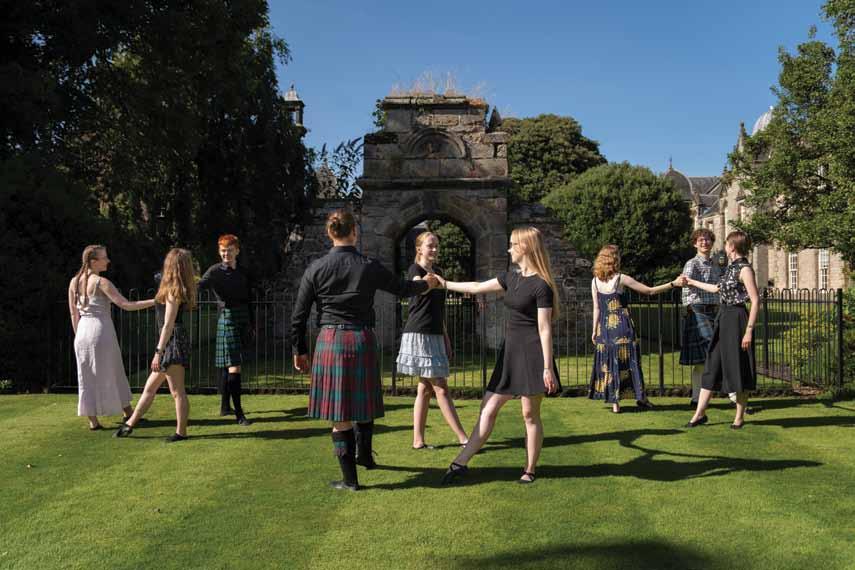
Throughout the week dancers will be taught by different teachers, enjoy live music, and learn in a new venue so you can experience first-hand the world class atmosphere Summer School has to offer. All dancers will attend a Scottish country dance class of their own ability each morning with different activities taking place in the afternoons.
